U.S. Department of Transportation
Federal Highway Administration
1200 New Jersey Avenue, SE
Washington, DC 20590
202-366-4000
Federal Highway Administration Research and Technology
Coordinating, Developing, and Delivering Highway Transportation Innovations
| REPORT |
| This report is an archived publication and may contain dated technical, contact, and link information |
|
| Publication Number: FHWA-HRT-15-074 Date: September 2016 |
Publication Number: FHWA-HRT-15-074 Date: September 2016 |
This chapter presents details concerning the analytical investigation undertaken to explore relationships between load-induced structural-related responses of a pavement system and the corresponding surface deflection basin-related indices. This investigation and associated results were considered an important effort toward the development of methodologies for incorporating TSDD measurements into network-level PMS applications.
Pavement failure (or structural capacity), in terms of fatigue or rutting can be estimated from performance prediction equations.(27,57) These equations relate load-induced pavement responses to the following two important pavement distresses: (1) certain level of AC fatigue cracking and (2) rutting failure in the subgrade. The critical load-induced pavement responses that relate to the two referenced distresses are the maximum tensile horizontal strain (also known as fatigue strain) at the bottom of the AC layer and the vertical compressive strain on top of the subgrade, respectively. In addition, there are studies that postulate the existence of reliable correlations between deflection basin- related indices and load-induced pavement structural responses, which suggest it is possible to correlate deflection basin indices to structural capacity (or distress).(62,63,21)
Specific TSDD deflection basin measurements depend on the device under consideration. For example, the TSD device measures surface vertical velocity at as many as nine locations within the deflection bowl, and subsequently, the surface vertical deflection basin is determined based on a certain assumption for the shape of the defection basin. Conversely, only two surface measurements within the deflection bowl are taken by the RWD. In turn, this means that the selection of deflection basin indices for correlation to structural capacity (or distress) must take into consideration the capabilities of the specific TSDD.
Chapter 7 of this report detailed the validation of the 3D-Move program, for the purposes of the project in question, using a variety of independent pavement responses that included surface deflection bowls (measured using project sensors) as well as horizontal strains at the bottom of the AC layers and vertical stresses at the top of the subgrade (measured using MnROAD sensors). Accordingly, the program was ready for the evaluation of the critical pavement responses and corresponding deflection-based indices, thus enabling the investigation of correlations between the two. Because 3D-Move uses a dynamic moving load model, important factors such as viscoelastic properties and vehicle speed can be accounted for in the evaluation of pavement response time histories.
A number of previous studies have proposed many surface vertical deflection-based indices, and they have also postulated that these indices relate to the structural capacity of pavements.(62,63,21) However, for the purposes of this project, it was important to identify those indices that best relate to the two critical pavement responses. The identification of the appropriate indices was undertaken using the following three-step procedure:
These three steps used to identify the most appropriate indices are described in greater detail in the following subsections.
As a part of the calibration process described in chapter 7, pavement responses using 3D-Move were computed for three MnROAD accuracy cells with the TSDDs travelling at various vehicle speeds. By trial and error, three pavement case scenarios were identified for each of the accuracy cells, which bracketed the vertical surface deflection bowls computed by 3D-Move with those measured by the project sensors. In all, 42 datasets of pavement responses and corresponding vertical surface deflections datasets were generated using 3D-Move.
The 3D-Move program can output many response time histories (e.g., stresses, strains, displacements, and velocities) as a vehicle travels on at any specified location of the pavement surface. The TSDDs measured (or estimated) vertical surface deflections at many predetermined locations in the longitudinal direction along the midline between the rear tires (see figure 166). From the vertical displacement time history computed by 3D-Move at a point (observation point) on the midline between the tires, it was possible to determine the displacements at various individual locations along the midline using time space superposition. The 3D-Move output includes the time of the maximum displacement (tmax) and also the time (to) at which the instantaneous deflection at the midpoint between tires (D0) reached the point of observation (see figure 167). Since 3D-Move modeled the damping characteristics of the pavement layers, there was an offset between tmax and to. The location Dr refers to a point at a distance r in inches in front of D0. The maximum displacement that occurred at the location Dmax and other displacements at many locations shown along the midline between the tires in figure 166 could be readily determined using time-space superposition.
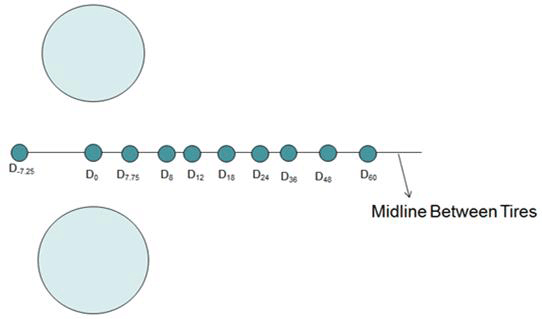
Figure 166. Illustration. Predetermined locations for estimation of vertical surface deflections in TSDDs.
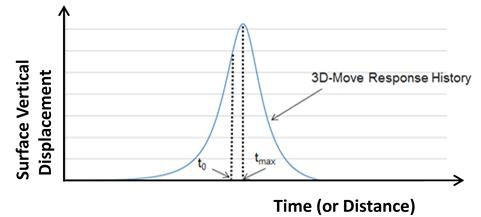
Figure 167. Illustration. Surface displacement from 3D-Move displacement time history.
Conversely, when other 3D-Move pavement responses (e.g., maximum AC tensile strain) were considered, it was necessary to select multiple transverse locations (the depth was fixed) in the computations. This is because the location of the maximum value of the response was not known a priori. After computing responses at many multiple transverse locations, the maximum response value could be determined.
Though the focus of this project was on the horizontal (or fatigue) strains at the bottom the AC and to a lesser extent on the vertical strains at the top of subgrade, a larger database of pavement responses was assembled from the 3D-Move runs. The list of the locations and corresponding responses and the distress mode includes the following (see figure 168):
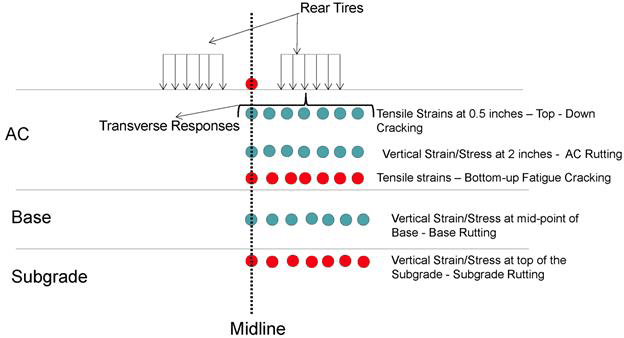
1 inch = 25.4 mm
Figure 168. Illustration. Selection of response points when using 3D-Move.
The initial focus of the simulations was on the three MnROAD cells (cells 3, 19, and 34), where project sensor measurements were taken during the TSDD field trials. A sketch of the pavement structures at these three cells was presented earlier in figure 141 (see chapter 7). Since the AC thickness varied from 3 to 5 inches (76.2 to 127 mm) along these cells, the sections could be categorized as pavements with relatively thin AC. Other pavement layer thicknesses and moduli are also shown in this figure. To compare the 3D-Move results to measured data from the MnROAD and project sensors, the AC moduli corresponding to the temperatures at the time of the TSDD field trials were required. The procedure to get the AC layer modulus versus frequency relation at any given temperature based on FWD backcalculated layer moduli was described in chapter 7. Figure 138 and figure 139 in chapter 7 showed the axle configuration and loads for the TSD and RWD. These two cases of loading (tire loads, pressure, and spacing) could be used to determine the role of loading conditions on the correlations between surface deflection indices and pavement responses as described later in this chapter.
A number of deflection basin-related indices have been proposed by researchers and are perceived as strong predictors of the critical structural-related responses and structural conditions (or capacity) of the pavements. Experimental and analytical studies have reported strong correlations between some deflection basin indices and pavement responses.(62,63,21) Horak proposed two different equations for R referred as R1 and R2 as in Figure 8 and Figure 9.(63,64)
As noted previously, the 3D-Move deflection basin parameters were computed based on surface vertical displacement along the midline between the two rear tires, while the maximum pavement responses were determined by considering many transverse response locations. The 3D-Move runs initially used both the TSD and RWD loadings individually, and then the combined dataset were used when exploring the correlations. A power curve generally described the data better than a linear fit, as judged by improved correlation coefficients (R2).
SCI is typically defined as the difference in displacements between D0 and Dr. D0 is the reference displacement; however, the locations D0 and Dmax were not the same due to viscous lag of the response due to the moving load. Accordingly, it was important to determine whether a better correlation existed if Dmax was used as the reference displacement. Parameter SCIm is defined by using Dmax instead of D0 as the reference displacement in the calculations of the indices. Since both TSD and RWD did not directly measure deflection at D0, another observation made during the investigation was the need to also consider D4, D-7.25, and D8 (i.e., displacements at 4, -7.25, and 8 inches (101.6, -184.15, and 203.2 mm), respectively) as reference displacement locations. In the case of the TSD, because of its capacity to measure multiple deflection points, a theoretical algorithm was used to compute D0. However, to minimize additional computations and associated errors, the possibility of utilizing direct TSD measurements at D4 and D8 were proposed. More specifically, a new index called Deflection Slope Index (DSI) was proposed based on reference at D4, D8, D12, D18, and D24. DSI is the difference between the deflection at reference location and Dr. In addition, indices representing deflection slope at a given location defined as Tangent Slope (TS) was also considered.
Table 44 shows these indices. A total of 75 individual indices are listed in this table. The deflection basin indices included in table 44 correlated with the two pavement structural-related responses presented earlier in this chapter. The deflection basin parameters that did not yield strong correlations to the structural-related responses were not considered further under the third step.
| Parameter and Number of Indices | Indices for Evaluation |
|---|---|
| R1 (7) | R18 |
| R112 | |
| R118 | |
| R124 | |
| R136 | |
| R148 | |
| R160 | |
| R2 (7) | R28 |
| R212 | |
| R218 | |
| R224 | |
| R236 | |
| R248 | |
| R260 | |
| Surface displacement (2) | D0 |
| D60 | |
| Area (1) | A |
| Shape factors (2) | F1 |
| F2 | |
| SCI (7) | SCI8 |
| SCI12 | |
| SCI18 | |
| SCI24 | |
| SCI36 | |
| SCI48 | |
| SCI60 | |
| D-7.25 - D7.75 (for RWD) | |
| BCI (1) | BCI |
| BDI (1) | BDI |
| AUPP (1) | AUPP |
| SD (7) | SD8 |
| SD12 | |
| SD18 | |
| SD24 | |
| SD36 | |
| SD48 | |
| SD60 | |
| TS (8) | TS4* |
| TS8* | |
| TS12* | |
| TS18 | |
| TS24* | |
| TS36* | |
| TS48 | |
| TS60* | |
| SCIm (7) | SCIm8 |
| SCIm12 | |
| SCIm18 | |
| SCIm24 | |
| SCIm36 | |
| SCIm48 | |
| SCIm60 | |
| DSI4-r (7) | DSI4 - 8 |
| DSI4 - 12 | |
| DSI4 - 18 | |
| DSI4 - 24 | |
| DSI4 - 36 | |
| DSI4 - 48 | |
| DSI4 - 60 | |
| DSI8 - r (6) | DSI8 - 12 |
| DSI8 - 18 | |
| DSI8 - 24 | |
| DSI8 - 36 | |
| DSI8 - 48 | |
| DSI8 - 60 | |
| DSI12 - r (4) | DSI12 - 18 |
| DSI12 - 24 (same as BDI) | |
| DSI12 - 36 | |
| DSI12 - 48 | |
| DSI12 - 60 | |
| DSI18 - r (4) | DSI18 - 24 |
| DSI18 - 36 | |
| DSI18 - 48 | |
| DSI18 - 60 | |
| DSI24 - r (2) | DSI24 - 36 (same as BCI) |
| DSI24 - 48 | |
| DSI24 - 60 |
*TSD sensor location.
Note: Numbers within parentheses in left column indicate the number of indices for each deflection basin parameter.
The goodness of the correlations between the indices and pavement responses were categorized into three classes. Class 1 indices had an R2 greater than 0.9 and were considered the most appropriate indices. Class 2 indices were those with an R2 between 0.7 and 0.9, and class 3 indices were those with an R2 less than 0.7.
Two options were used when horizontal strains at the bottom AC were considered: (1) maximum tensile strains in transverse and longitudinal direction of vehicle travel and (2) maximum tensile strains at a location directly below the midpoint between the rear tires. For the purpose of brevity, only the following tables and figures that showed the highest (and therefore the most appropriate) correlations are included in this chapter:
The equations with R2 values more than 0.90 are presented bold. The example tables and figures provide results for TSD loadings only and also for the combined TSD and RWD loadings. There are 17 data points available for the TSD loadings and 43 for the combined dataset. Similar tables and figures looking at the fatigue strain relationship were developed for every index in table 44, but they are not included in the report, as they do not provide further insights. The data used to generate these tables and figures can be obtained directly from FHWA.
Based on the information presented in table 45 through table 52 and the review of the correlations for other indices, it was concluded that indices based on maximum horizontal strains were better than horizontal strains at the location directly below the midpoint between the tires. It was also concluded that the role of the difference in load characteristics (TSD versus RWD) on the relationships were minimal. However, SCIm, which used Dmax as the reference displacement, had a slightly better correlation. It also appears that using D4 instead of D0 to calculate SCI yielded better correlations.
| Index | Relation with Midline Horizontal Strain* | Relation with Maximum Horizontal Strain* | ||
|---|---|---|---|---|
| Equation | R2 | Equation | R2 | |
| R18 | y = 3.3238x-1.02 | 0.75 | y = 1.2327x-0.896 | 0.88 |
| R112 | y = 1.3707x-0.912 | 0.85 | y = 0.4438x-0.775 | 0.94 |
| R118 | y = 0.5819x-0.791 | 0.88 | y = 0.1802x-0.655 | 0.92 |
| R124 | y = 0.4157x-0.73 | 0.88 | y = 0.1241x-0.595 | 0.89 |
| R136 | y = 0.397x-0.684 | 0.87 | y = 0.1115x-0.551 | 0.86 |
| R148 | y = 0.5396x-0.682 | 0.87 | y = 0.1395x-0.547 | 0.85 |
| R160 | y = 0.7837x-0.69 | 0.87 | y = 0.1866x-0.553 | 0.85 |
*At the bottom of AC layer.
y = Horizontal strain.
x = Index.
Note: There were 17 TSD loading data points. Bold cells indicate indices in class 1.
| Index | Relation with Midline Horizontal Strain* | Relation with Maximum Horizontal Strain* | ||
|---|---|---|---|---|
| Equation | R2 | Equation | R2 | |
| R18 | y = 6.2386x-1.091 | 0.74 | y = 1.2078x-0.895 | 0.88 |
| R112 | y = 2.2986x-0.968 | 0.87 | y = 0.3945x-0.763 | 0.95 |
| R118 | y = 0.9436x-0.843 | 0.91 | y = 0.1584x-0.643 | 0.93 |
| R124 | y = 0.6542x-0.778 | 0.91 | y = 0.1079x-0.583 | 0.90 |
| R136 | y = 0.6504x-0.733 | 0.90 | y = 0.0994x-0.542 | 0.87 |
| R148 | y = 0.9188x-0.732 | 0.89 | y = 0.125x-0.539 | 0.85 |
| R160 | y = 1.3733x-0.742 | 0.89 | y = 0.1666x-0.545 | 0.85 |
*At the bottom of AC layer.
y = Horizontal strain.
x = Index.
Note: There were 43 data points from both TSD and RWD loading. Bold cells indicate indices in class 1.
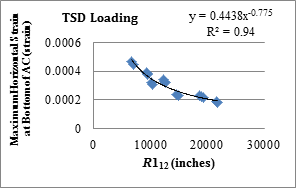
1 inch = 25.4 mm
Figure 169. Graph. Relationship between R112 and horizontal strains at bottom of AC with TSD loading data.
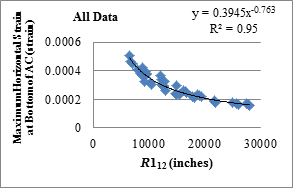
1 inch = 25.4 mm
Figure 170. Graph. Relationship between R112 and horizontal strains at bottom of AC with all loading data.
| Index | Relation with Midline Horizontal Strain* | Relation with Maximum Horizontal Strain* | ||
|---|---|---|---|---|
| Equation | R2 | Equation | R2 | |
| SCI8 | y = 0.0969x1.0201 | 0.75 | y = 0.0553x0.8958 | 0.88 |
| SCI12 | y = 0.0277x0.9119 | 0.85 | y = 0.0161x0.775 | 0.94 |
| SCI18 | y = 0.0104x0.7911 | 0.88 | y = 0.0064x0.6547 | 0.92 |
| SCI24 | y = 0.0067x0.73 | 0.88 | y = 0.0043x0.5948 | 0.89 |
| SCI36 | y = 0.0047x0.6841 | 0.87 | y = 0.0031x0.551 | 0.86 |
| SCI48 | y = 0.0044x0.6817 | 0.87 | y = 0.003x0.547 | 0.85 |
*At the bottom of AC layer.
y = Horizontal strain.
x = Index.
Note: There were 17 TSD loading data points. Bold cells indicate indices in class 1.
| Index | Relation with Midline Horizontal Strain* | Relation with Maximum Horizontal Strain* | ||
|---|---|---|---|---|
| Equation | R2 | Equation | R2 | |
| SCI8 | y = 0.142x1.0914 | 0.74 | y = 0.0543x0.8949 | 0.88 |
| SCI12 | y = 0.0365x0.9684 | 0.87 | y = 0.0151x0.7626 | 0.95 |
| SCI18 | y = 0.0129x0.8432 | 0.91 | y = 0.006x0.6427 | 0.93 |
| SCI24 | y = 0.008x0.778 | 0.91 | y = 0.004x0.5827 | 0.90 |
| SCI36 | y = 0.0056x0.7335 | 0.90 | y = 0.003x0.5422 | 0.86 |
| SCI48 | y = 0.0053x0.7324 | 0.89 | y = 0.0028x0.5392 | 0.85 |
*At the bottom of AC layer.
y = Horizontal strain.
x = Index.
Note: There were 43 data points from both TSD and RWD loading. Bold cells indicate indices in class 1.
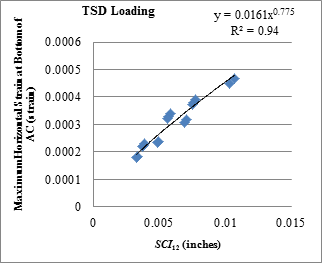
1 inch = 25.4 mm
Figure 171. Graph. Relationship between SCI12 and horizontal strains at bottom of AC with TSD loading data.
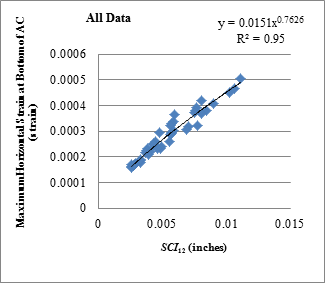
1 inch = 25.4 mm
Figure 172. Graph. Relationship between SCI12 and horizontal strains at bottom of AC with all loading data.
| Index | Relation with Midline Horizontal Strain* | Relation with Maximum Horizontal Strain* | ||
|---|---|---|---|---|
| Equation | R2 | Equation | R2 | |
| SCIm8 | y = 0.0713x0.9751 | 0.76 | y = 0.0417x0.854 | 0.89 |
| SCIm12 | y = 0.0234x0.883 | 0.84 | y = 0.014x0.7505 | 0.92 |
| SCIm18 | y = 0.0096x0.7774 | 0.88 | y = 0.0061x0.6437 | 0.92 |
| SCIm24 | y = 0.0063x0.7211 | 0.87 | y = 0.0041x0.5879 | 0.89 |
| SCIm36 | y = 0.0046x0.6782 | 0.87 | y = 0.0031x0.5465 | 0.86 |
| SCIm48 | y = 0.0043x0.6763 | 0.86 | y = 0.0029x0.5429 | 0.85 |
*At the bottom of AC layer.
y = Horizontal strain.
x = Index.
Note: There were 17 TSD loading data points. Bold cells indicate indices in class 1.
| Index | Relation with Midline Horizontal Strain* | Relation with Maximum Horizontal Strain* | ||
|---|---|---|---|---|
| Equation | R2 | Equation | R2 | |
| SCIm8 | y = 0.1022x1.0439 | 0.77 | y = 0.0407x0.8526 | 0.91 |
| SCIm12 | y = 0.0306x0.9386 | 0.87 | y = 0.0131x0.739 | 0.95 |
| SCIm18 | y = 0.012x0.8292 | 0.91 | y = 0.0057x0.6323 | 0.93 |
| SCIm24 | y = 0.0076x0.7689 | 0.91 | y = 0.0038x0.5763 | 0.89 |
| SCIm36 | y = 0.0055x0.7274 | 0.90 | y = 0.0029x0.538 | 0.86 |
| SCIm48 | y = 0.0051x0.7268 | 0.89 | y = 0.0027x0.5354 | 0.85 |
*At the bottom of AC layer.
y = Horizontal strain.
x = Index.
Note: There were 43 data points from both TSD and RWD loading. Bold cells indicate indices in class 1.
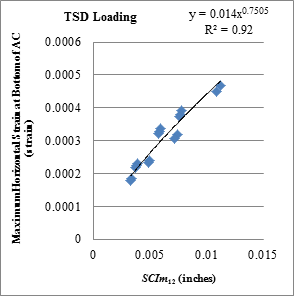
1 inch = 25.4 mm
Figure 173. Graph. Relationship between SCIm12 and horizontal strains at bottom of AC with TSD loading data.

1 inch = 25.4 mm
Figure 174. Graph. Relationship between SCIm12 and horizontal strains at bottom of AC with all loading data.
| Index | Relation with Midline Horizontal Strain* | Relation with Maximum Horizontal Strain* | ||
|---|---|---|---|---|
| Equation | R2 | Equation | R2 | |
| DSI4 - 8 | y = 0.0641x0.9153 | 0.79 | y = 0.0357x0.7917 | 0.90 |
| DSI4 - 12 | y = 0.0201x0.8324 | 0.84 | y = 0.0119x0.7019 | 0.91 |
| DSI4 - 18 | y = 0.0086x0.7386 | 0.87 | y = 0.0054x0.6079 | 0.90 |
| DSI4 - 24 | y = 0.0057x0.6872 | 0.87 | y = 0.0037x0.5573 | 0.87 |
*At the bottom of AC layer.
y = Horizontal strain.
x = Index.
Note: There were 17 TSD loading data points. Bold cells indicate indices in class 1.
| Index | Relation with Midline Horizontal Strain* | Relation with Maximum Horizontal Strain* | ||
|---|---|---|---|---|
| Equation | R2 | Equation | R2 | |
| DSI4 - 8 | y = 0.0891x0.9776 | 0.82 | y = 0.0337x0.7862 | 0.93 |
| DSI4 - 12 | y = 0.0257x0.8833 | 0.88 | y = 0.0111x0.6886 | 0.94 |
| DSI4 - 18 | y = 0.0104x0.7857 | 0.91 | y = 0.005x0.5947 | 0.91 |
| DSI4 - 24 | y = 0.0067x0.7313 | 0.90 | y = 0.0035x0.5445 | 0.88 |
*At the bottom of AC layer.
y = Horizontal strain.
x = Index.
Note: There were 43 data points from both TSD and RWD loading. Bold cells indicate indices in class 1.
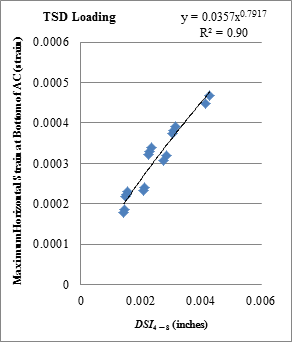
1 inch = 25.4 mm
Figure 175. Graph. Relationship between DSI4 - 8 and horizontal strains at bottom of AC with TSD loading data.
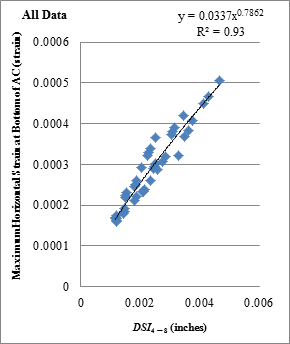
1 inch = 25.4 mm
Figure 176. Graph. Relationship between DSI4 - 8 and horizontal strains at bottom of AC with all loading data.
Because vertical strain at the top of the subgrade is an important response that relates to subgrade rutting, the deflection basin indices considered were also correlated with those strains.
Table 53, table 54, figure 177, and figure 178 show the relationships between SCI and vertical strain at the top of the subgrade. While SCI (e.g., SCI12) was one of the most appropriate indices related to maximum horizontal strain at the bottom of AC, it cannot be used to relate to subgrade strain because of poor correlation.
| Index | Relation with Maximum Vertical Strain* | |
| Equation | R2 | |
| SCI8 | y = 1E+07x1.7785 | 0.38 |
| SCI12 | y = 6E+06x1.904 | 0.62 |
| SCI18 | y = 2E+06x1.7981 | 0.76 |
| SCI24 | y = 815968x1.7374 | 0.84 |
| SCI36 | y = 447767x1.6776 | 0.88 |
| SCI48 | y = 402727x1.6869 | 0.89 |
| SCI60 | y = 414955x1.7136 | 0.89 |
*On top of subgrade.
y = Vertical strain.
x = Index.
Note: There were 17 TSD loading data points.
| Index | Relation with Maximum Vertical Strain* | |
|---|---|---|
| Equation | R2 | |
| SCI8 | y = 9E+06x1.752 | 0.39 |
| SCI12 | y = 4E+06x1.8178 | 0.62 |
| SCI18 | y = 1E+06x1.7333 | 0.78 |
| SCI24 | y = 621344x1.6678 | 0.84 |
| SCI36 | y = 360860x1.6188 | 0.88 |
| SCI48 | y = 328608x1.63 | 0.89 |
| SCI60 | y = 335884x1.654 | 0.90 |
*On top of subgrade.
y = Vertical strain.
x = Index.
Note: There were 43 data points from both TSD and RWD loading. Bold cells indicate indices in class 1.
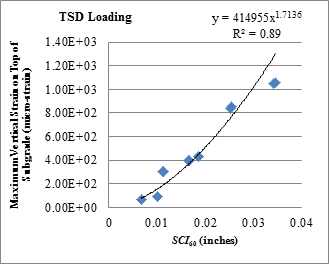
1 inch = 25.4 mm
Figure 177. Graph. Relationship between SCI60 and maximum vertical strain on top of the subgrade with TSD loading data.
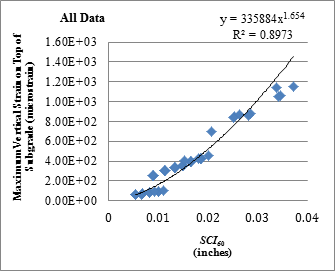
1 inch = 25.4 mm
Figure 178. Graph. Relationship between SCI60 and maximum vertical strain on top of the subgrade with all loading data.
Table 55, table 56, figure 179, and figure 180 show the relationships between DSI24 - r and vertical strain at the top of the subgrade. DSI24 - 36, which is also known as BCI, had a good correlation, indicated by class 1 classification. Moreover, it was observed that those indices based on displacements at far away locations from the loaded area were better related to vertical strain at the top of the subgrade. This is because these indices reflect the influence of the lower portion of the pavement system.(62,63) Similar tables and figures looking at the rutting strain relationship were developed for every index in table 44, but they are not included in this report as they do not provide further insights. The data used to generate these tables and figures can be obtained directly from FHWA.
| Index | Relation with Maximum Vertical Strain* | |
|---|---|---|
| Equation | R2 | |
| DSI24 - 36 | y = 937463x1.3155 | 0.97 |
| DSI24 - 48 | y = 994720x1.4238 | 0.97 |
| DSI24 - 60 | y = 1E+06x1.5332 | 0.97 |
*On top of subgrade.
y = Vertical strain.
x = Index.
Note: There were 17 TSD loading data points. Bold cells indicate indices in class 1.
| Index | Relation with Maximum Vertical Strain* | |
|---|---|---|
| Equation | R2 | |
| DSI24 - 36 | y = 880697x1.3031 | 0.98 |
| DSI24 - 48 | y = 936915x1.4106 | 0.97 |
| DSI24 - 60 | y = 1E+06x1.5125 | 0.97 |
*On top of subgrade.
y = Vertical strain.
x = Index.
Note: There were 43 data points from both TSD and RWD loading. Bold cells indicate indices in class 1.
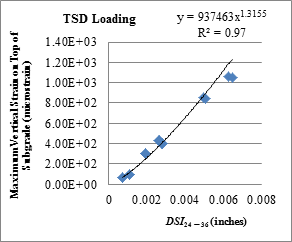
1 inch = 25.4 mm
Figure 179. Graph. Relationship between DSI24 - 36 and maximum vertical strain on top of the subgrade with TSD loading data.
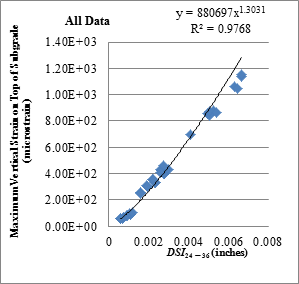
1 inch = 25.4 mm
Figure 180. Graph. Relationship between DSI24 - 36 and maximum vertical strain on top of the subgrade with all loading data.
Table 57 through table 60 summarize the most appropriate indices for TSD and for the combined data (TSD and RWD) against maximum horizontal strain at the bottom of the AC and maximum vertical strain on the top of subgrade, respectively. Some of the most significant observations from these tables are as follows (see table 44 for definitions of indices):
While SCI12 was found to be one of the most appropriate indices for maximum horizontal strain at the bottom of the AC (R2 = 0.95), it was not a good index for subgrade vertical strain (R2 = 0.62).
| Best Indices with TSD Loading (Relationship with Maximum Horizontal Strain) |
Index | R2 |
|---|---|---|
| R1 | R112 | 0.94 |
| R118 | 0.92 | |
| R2 | R218 | 0.92 |
| R224 | 0.94 | |
| R236 | 0.90 | |
| SCI | SCI12 | 0.94 |
| SCI18 | 0.92 | |
| SCIm12 | 0.92 | |
| SCIm18 | 0.91 | |
| DSI | DSI4 - 8 | 0.90 |
| DSI4 - 12 | 0.91 | |
| DSI4 - 18 | 0.90 | |
| SD | SD12 | 0.93 |
| SD18 | 0.92 | |
| TS | TS8 | 0.93 |
| TS24 | 0.91 | |
| AUPP | Am | 0.90 |
| Best Indices with All Data (Relationship with Maximum Horizontal Strain) |
Index | R2 |
|---|---|---|
| R1 | R112 | 0.95 |
| R118 | 0.93 | |
| R2 | R218 | 0.95 |
| R224 | 0.94 | |
| SCI | SCI12 | 0.95 |
| SCI18 | 0.93 | |
| SCIm8 | 0.91 | |
| SCIm12 | 0.95 | |
| SCIm18 | 0.93 | |
| DSI | DSI4 - 8 | 0.93 |
| DSI4 - 12 | 0.94 | |
| DSI4 - 18 | 0.91 | |
| DSI8 - 12 | 0.92 | |
| SD | SD12 | 0.95 |
| SD18 | 0.93 | |
| TS | TS8 | 0.94 |
| AUPP | Am | 0.91 |
| Best Indices with TSD Loading (Relationship with Maximum Vertical Strain at Top of Subgrade) |
Index | R2 |
|---|---|---|
| R2 | R260 | 0.92 |
| DSI | DSI4 - 48 | 0.90 |
| DSI4 - 60 | 0.90 | |
| DSI8 - 36 | 0.92 | |
| DSI8 - 48 | 0.93 | |
| DSI8 - 60 | 0.93 | |
| DSI12 - 18 | 0.90 | |
| DSI12 - 24* | 0.94 | |
| DSI12 - 36 | 0.95 | |
| DSI12 - 48 | 0.95 | |
| DSI12 - 60 | 0.95 | |
| DSI18 - 24 | 0.97 | |
| DSI18 - 36 | 0.97 | |
| DSI18 - 48 | 0.97 | |
| DSI18 - 60 | 0.97 | |
| DSI24 - 36** | 0.97 | |
| DSI24 - 48 | 0.97 | |
| DSI24 - 60 | 0.97 | |
| TS | TS12 | 0.90 |
| TS18 | 0.92 | |
| TS36 | 0.95 | |
| Â Shape factor | F2 | 0.91 |
*Indicates BDI.
**Indicates BCI.
| Best Indices with All Data (Relationship with Maximum Vertical Strain at Top of Subgrade) |
Index | R2 |
|---|---|---|
| R2 | R248 | 0.90 |
| R260 | 0.93 | |
| DSI | DSI4 - 48 | 0.91 |
| DSI4 - 60 | 0.91 | |
| DSI8 - 24 | 0.91 | |
| DSI8 - 36 | 0.93 | |
| DSI8 - 48 | 0.94 | |
| DSI8 - 60 | 0.94 | |
| DSI12 - 18 | 0.92 | |
| DSI12 - 24* | 0.95 | |
| DSI12 - 36 | 0.96 | |
| DSI12 - 48 | 0.96 | |
| DSI12 - 60 | 0.96 | |
| DSI18 - 24 | 0.97 | |
| DSI18 - 36 | 0.98 | |
| DSI18 - 48 | 0.97 | |
| DSI18 - 60 | 0.97 | |
| DSI24 - 36** | 0.98 | |
| DSI24 - 48 | 0.97 | |
| DSI24 - 60 | 0.97 | |
| TS | TS18 | 0.91 |
| TS24 | 0.91 | |
| TS36 | 0.94 |
*Indicates BDI.
**Indicates BCI.
During the September 2013 TSDD field trials, pavement response data were collected using both project and MnROAD sensors. The project sensors collected surface displacements, while pavement responses (longitudinal AC strain and vertical stresses at the top of the subgrade) were collected by the MnROAD sensors.
The correlations between deflection indices and pavement responses can also be explored based solely on the measured data. From project sensors embedded at the pavement surface, the surface displacements along the midline of the tires in the longitudinal direction can be estimated. However, adjustments should be made to account for the time lag that exists between Dmax and D0. In addition, as pointed out in chapter 7, the lateral wheel wander can also affect the estimation of the midline deflections.
MnROAD sensors collected responses at interior pavement locations (see table 41), and they were also affected by the lateral wheel wander. In other words, the maximum responses given by the MnROAD sensors may not have been the actual maxima for the responses in question. Also, because MnROAD sensors that measured vertical stresses were considered unreliable (section 7.6), only the measured data from the longitudinal AC strain gauges were correlated.
Table 61 shows the best correlated indices from 3D-Move computed displacement bowls with respect to 3D-Move computed maximum AC strains and the measured maximum horizontal AC strains. R2 values of the correlations with computed displacements and maximum strains (i.e., both 3D-Move derived) are higher. It should be noted R2 values that are shown in the table correspond to the respective best curve-fit equations obtained for the relationship.
| Best Indices with All Data (Relationship with Maximum Horizontal Strain for 3D-Move and Measured Strain) |
Index | R2 from 3D-Move Relationships | R2 from Measured Relationships |
|---|---|---|---|
| R1 | R112 | 0.95 | 0.86 |
| R118 | 0.93 | 0.87 | |
| R2 | R218 | 0.95 | 0.88 |
| R224 | 0.94 | 0.89 | |
| SCI | SCI12 | 0.95 | 0.86 |
| SCI18 | 0.93 | 0.87 | |
| SCIm8 | 0.91 | 0.83 | |
| SCIm12 | 0.95 | 0.88 | |
| SCIm18 | 0.93 | 0.90 | |
| DSI | DSI4 - 8 | 0.93 | 0.83 |
| DSI4 - 12 | 0.94 | 0.85 | |
| DSI4 - 18 | 0.91 | 0.86 | |
| DSI8 - 12 | 0.92 | 0.85 | |
| SD | SD12 | 0.95 | 0.86 |
| SD18 | 0.93 | 0.87 | |
| TS | TS8 | 0.94 | 0.91 |
| AUPP | Am | 0.91 | 0.87 |
As noted previously, the RWD used two sensors within the deflection bowl to characterize the deflected pavement surface. The sensors were located 7.25 inches (184.15 mm) behind the rear wheels and 7.75 inches (196.85 mm) in front of the rear wheels, as shown in figure 19 in chapter 4. In addition to the accuracy evaluation of RWD laser sensor presented in chapter 6, a deflection basin measured from the project sensor was used to evaluate the effectiveness of positioning the sensor 7.25 inches (184.15 mm) behind the wheels in capturing the maximum deflection. The response lag between the time that the rear tire crosses over the sensor and the time when the maximum response occurred in the project sensor signal is reproduced in table 62 for RWD testing. Table 62 also shows the percent difference between the deflections measured 7.25 inches (184.15 mm) behind the rear axle (D-7.25) and Dmax. Response lag is a function of pavement stiffness and vehicle speed. Cell 3, which was the stiffest of the three cells tested, had the least response lag and percent difference. Also, as expected, response lag decreased as vehicle speed increased. In summary, for stiffer pavements, the maximum deflection occurred closer to the center of the tire when tested at 60 mi/h (96.9 km/h). The hypothesis that maximum deflection occurs 7.25 inches (184.15 mm) behind the tire is valid only for less stiff pavements tested at relatively lower traffic speeds and may not be valid for stiff pavements tested at 60mi/h (96.9 km/h).
As noted, a number of previous studies have concluded that curvature indices, which are evaluated based on the difference in surface deflection at two points, reflect the characteristics of the AC layer.(62,63,21) The only possible curvature index from RWD, D-7.25 – D7.75 was evaluated further in this study. Table 62 also summarizes the percent difference between the computed index (D-7.25 – D7.75) and SCI15 as computed from the deflection basin measured in project sensor. SCI15 is the difference between maximum deflection and the deflection 15 inches (381 mm) in front of maximum deflection. When the response lag was less than 7.25 inches (184.15 mm) as in stiff pavements, the two deflection measurements D-7.25 and D7.75 were made on either side of the deflection basin, thus increasing the difference between the actual and computed index. The accuracy of the index computed from RWD deflection was hampered by the measurement location, especially in stiff pavements. In order to improve the compatibility of the RWD device to wider pavement sections, it is suggested that the location of the sensor be positioned in front of the rear axle.
| Cell | Speed (mi/h) | RWD Response Lag (inches) | Percent Difference Between Deflection at D-7.25 and Dmax | Percent Difference Between Index (D-7.25 – D7.75) and SCI15 | ||
|---|---|---|---|---|---|---|
| 34 | 30 | 7.3 | 0.04 | 0.15 | -0.49 | -0.11 |
| 45 | 6.9 | 0.25 | 0.27 | |||
| 19 | 30 | 4.5 | 3.42 | 4.04 | 22.11 | 28.75 |
| 45 | 3.4 | 5.33 | 32.98 | |||
| 60 | 4 | 3.38 | 31.17 | |||
| 3 | 30 | 4.3 | 3.47 | 6.84 | 28.95 | 41.91 |
| 45 | 2.5 | 5.80 | 42.30 | |||
| 60 | 1.6 | 11.26 | 54.49 | |||
1 mi/h = 1.6 km/h
1 inch = 25.4 mm
In the previous section, 3D-Move runs for the MnROAD accuracy cells were used to find the surface deflection indices that correlated best with pavement responses. However, the pavements for the MnROAD accuracy cells were relatively thin, with AC layer thicknesses varying between 3 and 5 inches (76.2 and 127 mm). Factors such as AC layer thickness, modulus and vehicle speed can and do influence the deflection correlations. Accordingly, in this section, the details of the 3D-Move-based correlation investigation that used a variety of pavement structures with differing properties (thickness and modulus) and vehicle speeds are presented.
Figure 181 shows a generic pavement structure used in the analyses. For the AC layer, three thickness (3, 6, and 12 inches (76.2, 152.4, 304.8 mm)) and three moduli (200, 500, and 800 ksi (1.37, 3.44, and 5.51 GPa)) were considered. The base layer thickness and modulus were fixed at 12 inches (304.8 mm) and 60 ksi (0.41 GPa), respectively. Moduli of 10 and 20 ksi (0.07 and 0.14 GPa) were used for the subgrade layer. In addition, vehicle speeds of 30 and 60 mi/h (48.3 and 96.6 km/h) were used in the 3D-Move runs. This resulted in 36 combinations of pavement structures and vehicle speeds, as shown in table 63.
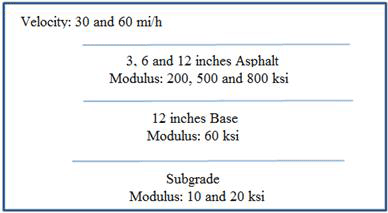
1 mi/h = 1.61 km/h
1 inch = 25.4 mm
1 ksi = 6.89 MPa
Figure 181. Illustration. Pavement structures used with 3D-Move analyses.
| Identification Key | AC Modulus at 30 Hz (ksi) | AC Thickness (inches) | Subgrade Modulus (ksi) | Vehicle Speed (mi/h) |
|---|---|---|---|---|
| B200-3-10-30 | 200 | 3 | 10 | 30 |
| B200-3-10-60 | 200 | 3 | 10 | 60 |
| B200-3-20-30 | 200 | 3 | 20 | 30 |
| B200-3-20-60 | 200 | 3 | 20 | 60 |
| B200-6-10-30 | 200 | 6 | 10 | 30 |
| B200-6-10-60 | 200 | 6 | 10 | 60 |
| B200-6-20-30 | 200 | 6 | 20 | 30 |
| B200-6-20-60 | 200 | 6 | 20 | 60 |
| B200-12-10-30 | 200 | 12 | 10 | 30 |
| B200-12-10-60 | 200 | 12 | 10 | 60 |
| B200-12-20-30 | 200 | 12 | 20 | 30 |
| B200-12-20-60 | 200 | 12 | 20 | 60 |
| B500-3-10-30 | 500 | 3 | 10 | 30 |
| B500-3-10-60 | 500 | 3 | 10 | 60 |
| B500-3-20-30 | 500 | 3 | 20 | 30 |
| B500-3-20-60 | 500 | 3 | 20 | 60 |
| B500-6-10-30 | 500 | 6 | 10 | 30 |
| B500-6-10-60 | 500 | 6 | 10 | 60 |
| B500-6-20-30 | 500 | 6 | 20 | 30 |
| B500-6-20-60 | 500 | 6 | 20 | 60 |
| B500-12-10-30 | 500 | 12 | 10 | 30 |
| B500-12-10-60 | 500 | 12 | 10 | 60 |
| B500-12-20-30 | 500 | 12 | 20 | 30 |
| B500-12-20-60 | 500 | 12 | 20 | 60 |
| B800-3-10-30 | 800 | 3 | 10 | 30 |
| B800-3-10-60 | 800 | 3 | 10 | 60 |
| B800-3-20-30 | 800 | 3 | 20 | 30 |
| B800-3-20-60 | 800 | 3 | 20 | 60 |
| B800-6-10-30 | 800 | 6 | 10 | 30 |
| B800-6-10-60 | 800 | 6 | 10 | 60 |
| B800-6-20-30 | 800 | 6 | 20 | 30 |
| B800-6-20-60 | 800 | 6 | 20 | 60 |
| B800-12-10-30 | 800 | 12 | 10 | 30 |
| B800-12-10-60 | 800 | 12 | 10 | 60 |
| B800-12-20-30 | 800 | 12 | 20 | 30 |
| B800-12-20-60 | 800 | 12 | 20 | 60 |
1 ksi = 6.89 MPa
1 inch = 25.4 mm
1 mi/h = 1.61 km/h
The impact of pavement temperature was reflected in the AC modulus; therefore, it was not considered an independent parameter. The AC modulus as a function of frequency (a master curve) needs to be specified as input when the viscoelastic material characteristics are considered in 3D-Move. The procedure to build a master curve from AC mix properties is explained in chapter 7. The AC modulus given in table 63 was considered appropriate for a frequency of 30 Hz when estimating the AC moduli as a function of frequency. Table 64 shows the AC mix properties used to develop the master curve for the effort in question.
| Variable | Value |
|---|---|
| Air Voids (percent) | 7 |
| Effective binder content (percent) | 11 |
| Void filled with asphalt (percent) | 61 |
| Percent retained for 0.75 inch | 11.62 |
| Percent retained for 0.375 inch | 35.3 |
| Percent retained #4 sieve | 52.64 |
| Percent passing #200 sieve | 7.28 |
| PG grade | 58-28 |
| Binder—regression intercept | 11.01 |
| Binder—VTS | -3.701 |
1 inch = 25.4 mm
The 75 indices listed in table 44 were reevaluated using the 3D-Move results from the 36 pavement structure and vehicle speed combinations detailed in the previous section. The sensitivity of those indices was investigated with respect to the following parameters: AC thickness and modulus, subgrade modulus, and vehicle speed. A major objective of this analysis was to isolate the parameters that most affect the indices. Once identified, those parameters could be used as a starting point in categorizing the pavements in the next step using JULEA.(26)
For the purpose of brevity, only selected figures showing notable conclusions are presented in this chapter. Similar figures to those presented in this chapter were developed for other deflection indices, but they are not included in this report, as they do not provide further insights. The data used to generate these figures can be obtained directly from FHWA.
Figure 182 shows the variation of SCI12 for the pavement combinations considered. The x-axis shows the key that can be used to identify easily a specific pavement combination (see table 63). In this graph, nine categories are shown with different fill patterns. For each category, the AC surface layer properties (AC thickness and AC modulus) remained constant. As shown, SCI12, which has been often viewed as an indicator of the influence of the AC layer, is strongly influenced by the AC thickness and modulus.
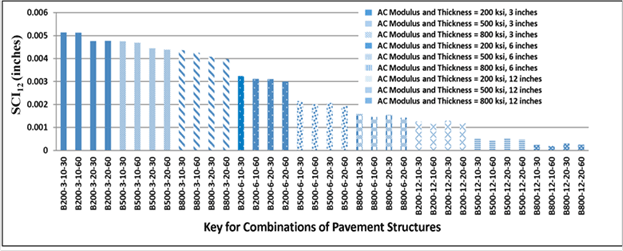
1 inch = 25.4 mm
Figure 182. Graph. Variation of SCI12 calculated with 3D-Move in simulated pavement combinations.
TS is potentially considered an important index because it is measured directly by the TSD, and thus uncertainties associated with algorithms needed to convert the measured deflection velocities to surface deflections are avoided. In general, TS showed high sensitivity to changes in the pavement layer properties (stiffness and thickness). In particular, TS48 and TS60 seemed to be mostly affected by subgrade modulus. For example, TS60 is clearly influenced by subgrade modulus (see figure 183). As is shown later in this chapter, TS4 and TS8 are better correlated with the maximum horizontal strain at the bottom of thin and thick AC layers, respectively.
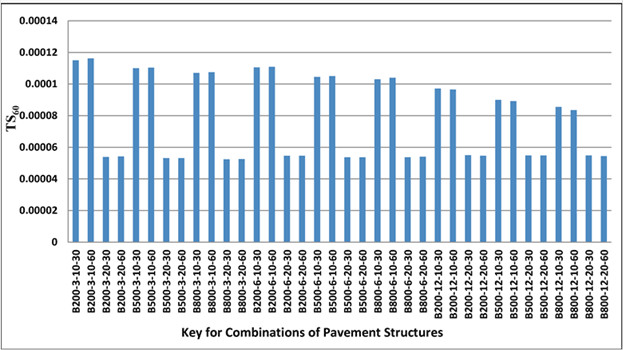
Figure 183. Graph. Variation of TS60 calculated with 3D-Move in simulated pavement combinations.
R as defined by Horak was significantly affected by the properties of the surface AC layer and slightly affected by the stiffness of the subgrade.(62,63) Figure 184 shows the variation in R60 for the pavement combinations considered.
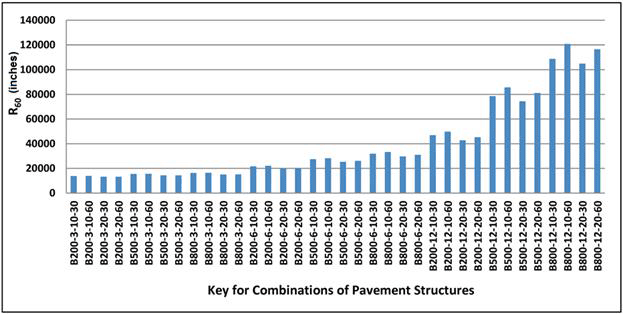
1 inch = 25.4 mm
Figure 184. Graph. Variation of R60 calculated with 3D-Move in simulated pavement combinations.
D60 seemed to be the most promising parameter for estimating the subgrade modulus, as shown in figure 185. This parameter seemed to be only affected by the subgrade modulus; other material properties did not have a noticeable influence.
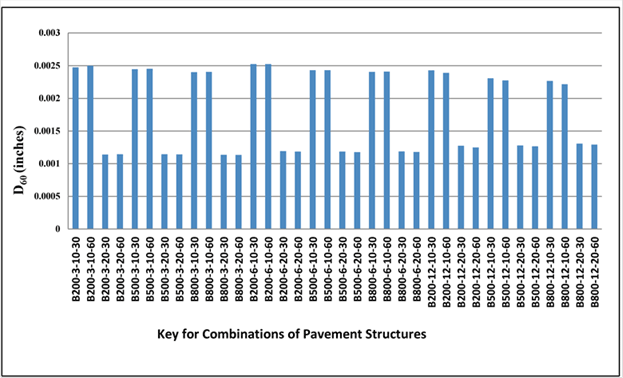
1 inch = 25.4 mm
Figure 185. Graph. Variation of D60 calculated with 3D-Move in simulated pavement combinations.
Figure 186 shows the variation in maximum horizontal strain at the bottom of the AC layer for various pavement combinations considered. Table 65 summarizes the response trends as a few of pavement-related parameters are increased one at a time. As shown in the referenced figure and table, increasing subgrade modulus affected the thin and thick pavements differently. For thin pavements, increasing the subgrade stiffness resulted in an increase in the horizontal strains at the bottom of the AC layer, while the opposite trend was observed for thick pavements (i.e., the strains decreased).
Figure 186. Graph. Variation of maximum horizontal strain at bottom of AC layer in simulated pavement combinations.
| Increase in Parameter | Maximum Horizontal Strain at Bottom of AC Layer |
|---|---|
| AC modulus | Decreased |
| AC thickness | Decreased |
| Speed | Decreased |
| Subgrade modulus | Thin AC (3 inches) increased; thick AC (12 inches) decreased |
1 inch = 25.4 mm
Figure 187 through figure 206 show the variability of the correlations of some of the indices to the maximum horizontal strain at the bottom of the AC layer. In all figures, the numbers within parentheses in the legends indicate the number of data points. One of the important interpretations from these figures is that the AC thickness impacted the strengths of the relationships as judged by the R2 values. Many indices did not consistently relate well with the maximum horizontal strain for thin (3 inches (76.2 mm)) AC pavements. Other material properties, such as the subgrade and AC moduli, also influenced the strengths of the relationships for thin pavements. Conversely, thick (12 inches (304.8 mm)) AC pavements were less sensitive to those parameters.
1 inch = 25.4 mm
Figure 187. Graph. Variability of relationships of R1 with maximum horizontal strain at bottom of AC layer for various AC thicknesses.
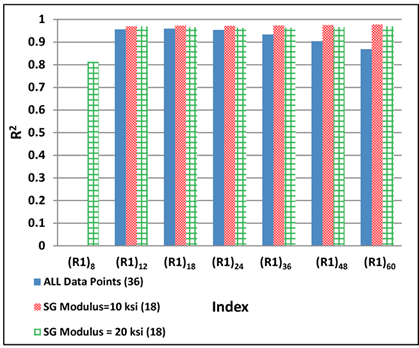
1 ksi = 6.89 MPa
Figure 188. Graph. Variability of relationships of R1 with maximum horizontal strain at bottom of AC layer for various subgrade moduli.
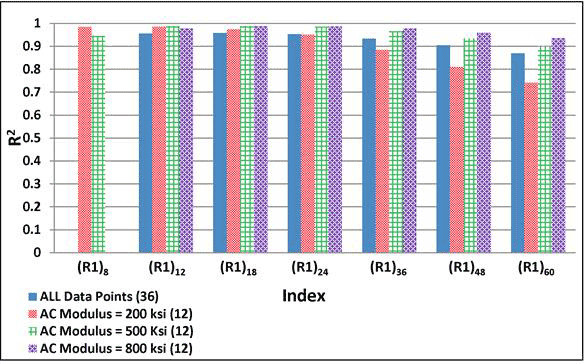
1 ksi = 6.89 MPa
Figure 189. Graph. Variability of relationships of R1 with maximum horizontal strain at bottom of AC layer for various AC moduli.
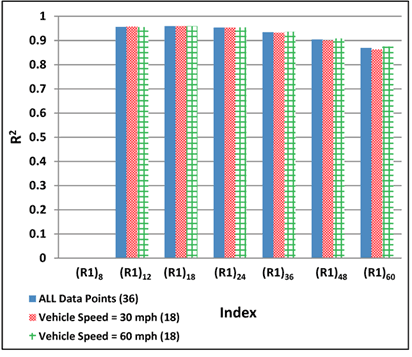
1 mi/h = 1.61 km/h
Figure 190. Graph. Variability of relationships of R1 with maximum horizontal strain at bottom of AC layer for various vehicle speeds.
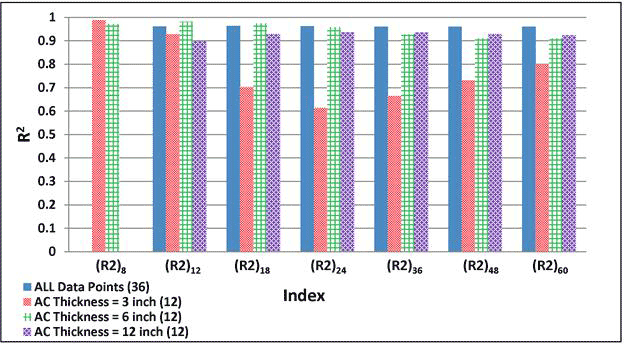
1 inch = 25.4 mm
Figure 191. Graph. Variability of relationships of R2 with maximum horizontal strain at bottom of AC layer for various AC thicknesses.
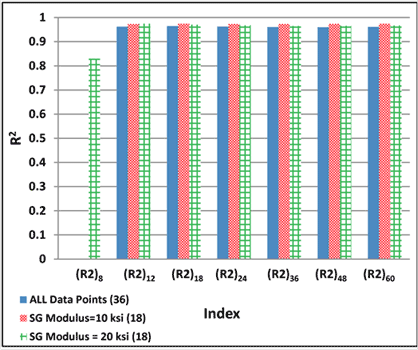
1 ksi = 6.89 MPa
Figure 192. Graph. Variability of relationships of R2 with maximum horizontal strain at bottom of AC layer for various subgrade moduli.

1 ksi = 6.89 MPa
Figure 193. Graph. Variability of relationships of R2 with maximum horizontal strain at bottom of AC layer for various AC moduli.
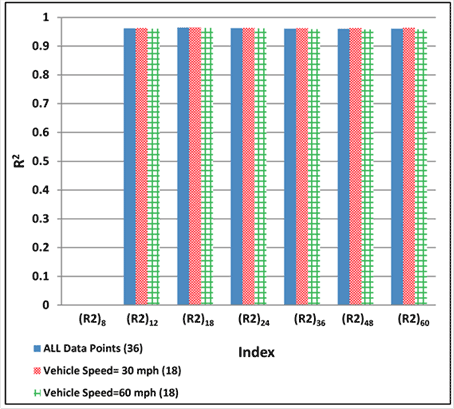
1 mi/h = 1.61 km/h
Figure 194. Graph. Variability of relationships of R2 with maximum horizontal strain at bottom of AC layer for various vehicle speeds.
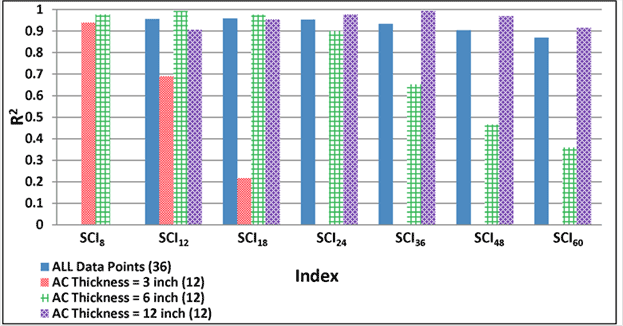
1 inch = 25.4 mm
Figure 195. Graph. Variability of relationships of SCI with maximum horizontal strain at bottom of AC layer for various AC thicknesses.
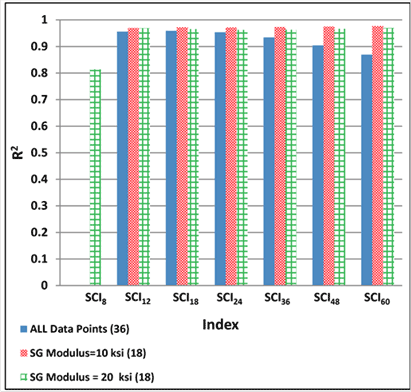
1 ksi = 6.89 MPa
Figure 196. Graph. Variability of relationships of SCI with maximum horizontal strain at bottom of AC layer for various subgrade moduli.
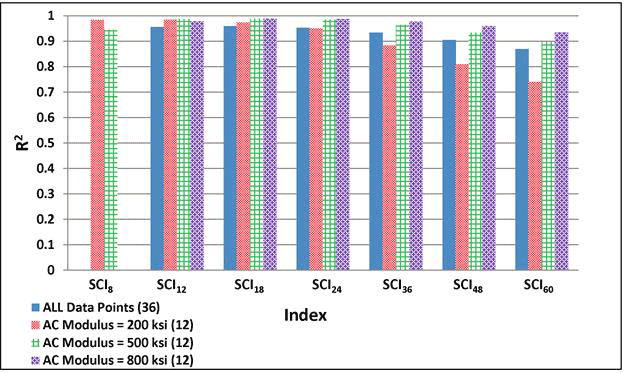
1 ksi = 6.89 MPa
Figure 197. Graph. Variability of relationships of SCI with maximum horizontal strain at bottom of AC layer for various AC moduli.
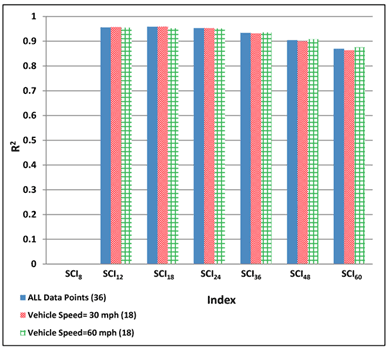
1 mi/h = 1.61 km/h
Figure 198. Graph. Variability of relationships of SCI with maximum horizontal strain at bottom of AC layer for various vehicle speeds.
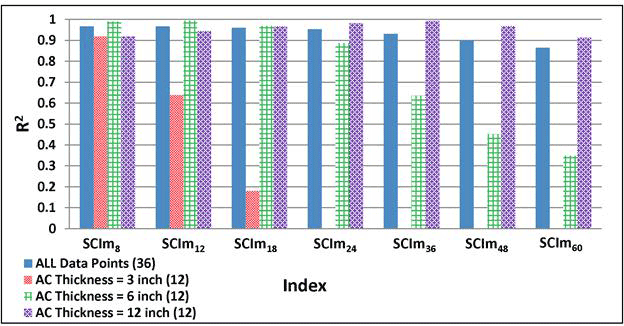
1 inch = 25.4 mm
Figure 199. Graph. Variability of relationships of SCIm with maximum horizontal strain at bottom of AC layer for various AC thicknesses.
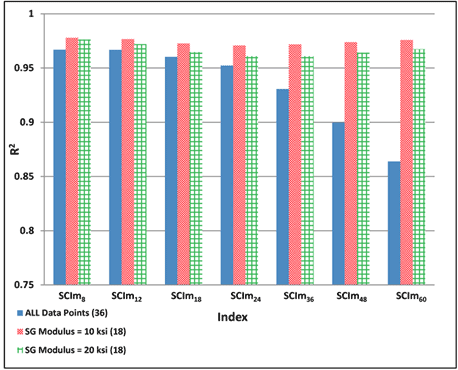
1 ksi = 6.89 MPa
Figure 200. Graph. Variability of relationships of SCIm with maximum horizontal strain at bottom of AC layer for various subgrade moduli.
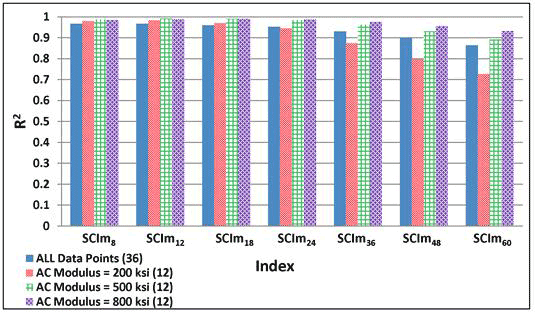
1 ksi = 6.89 MPa
Figure 201. Graph. Variability of relationships of SCIm with maximum horizontal strain at bottom of AC layer for various AC moduli.
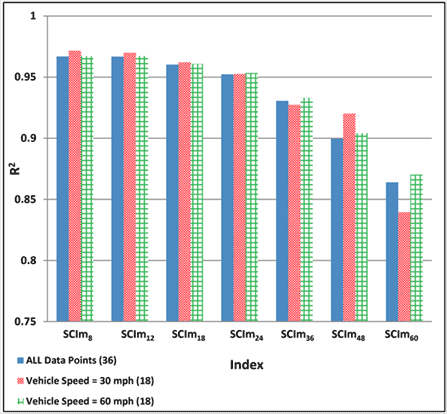
1 mi/h = 1.61 km/h
Figure 202. Graph. Variability of relationships of SCIm with maximum horizontal strain at bottom of AC layer for various vehicle speeds.
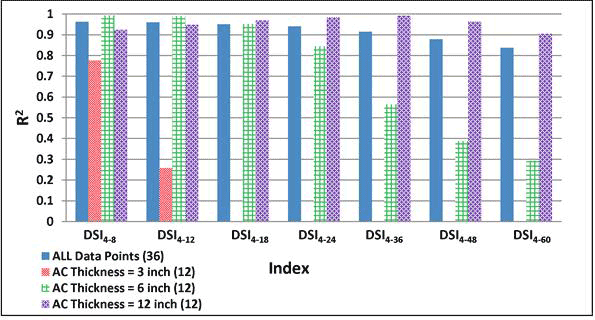
1 inch = 25.4 mm
Figure 203. Graph. Variability of relationships of DSI4 - r with maximum horizontal strain at bottom of AC layer for various AC thicknesses.
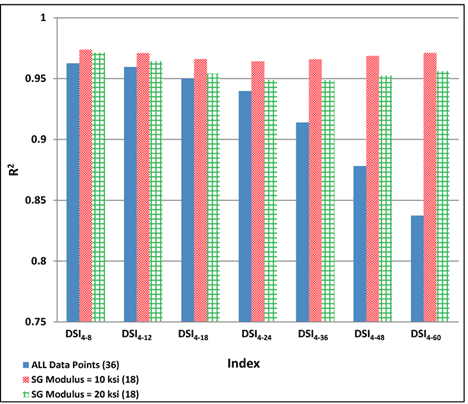
1 ksi = 6.89 MPa
Figure 204. Graph. Variability of relationships of DSI4 - r with maximum horizontal strain at bottom of AC layer for various subgrade moduli.
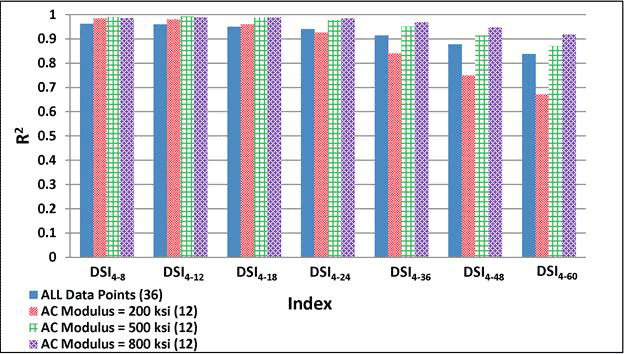
1 ksi = 6.89 MPa
Figure 205. Graph. Variability of relationships of DSI4 - r with maximum horizontal strain at bottom of AC layer for various AC moduli.
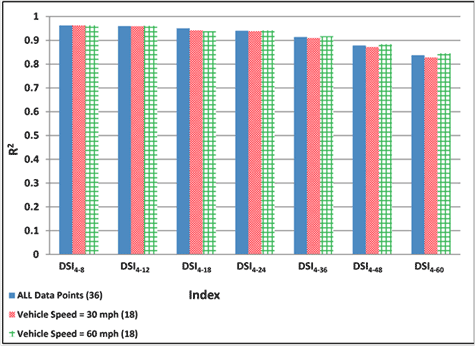
1 mi/h = 1.61 km/h
Figure 206. Graph. Variability of relationships of DSI4 - r with maximum horizontal strain at bottom of AC layer for various vehicle speeds.
Table 66 summarizes the goodness of fit for the relationships between each of the indices considered with the maximum horizontal strain at the bottom of the AC layer using a number of subsets. The subsets considered were AC thickness, subgrade modulus, AC modulus, and vehicle speed. Again, AC thickness was the most influential parameter. Subgrade modulus, AC modulus, and loading speed seemed to affect the most appropriate indices only marginally. However, further classifying the pavements based on subgrade modulus could improve the R2 of thin pavements.
| Relationship with Maximum Horizontal Strain | Index | R2 (All Data) (36 Cases) | Sensitivity Analysis with Respect to AC Thickness | Sensitivity Analysis with Respect to Subgrade Modulus | Sensitivity Analysis with Respect to AC Modulus | Sensitivity Analysis with Respect to Vehicle Speed | ||||||
|---|---|---|---|---|---|---|---|---|---|---|---|---|
| 3 inches (12 Cases) | 6 inches (12 Cases) | 12 inches (12 Cases) | 10 ksi (18 Cases) | 20 ksi (18 Cases) | 200 ksi (12 Cases) | 500 ksi (12 Cases) | 800 ksi (12 Cases) | 30 mi/h (18 Cases) | 60 mi/h (18 Cases) | |||
| R1 | R18 | N/A | 0.9384 | 0.9777 | N/A | N/A | 0.8131 | 0.9841 | 0.9453 | N/A | N/A | N/A |
| R112 | 0.9556 | 0.6898 | 0.9931 | 0.9052 | 0.9686 | 0.9681 | 0.9853 | 0.9878 | 0.9784 | 0.9569 | 0.9548 | |
| R118 | 0.9584 | 0.2165 | 0.9757 | 0.9547 | 0.971 | 0.9642 | 0.9741 | 0.9896 | 0.988 | 0.9586 | 0.9586 | |
| R124 | 0.9528 | Poor | 0.9001 | 0.9775 | 0.9704 | 0.9612 | 0.9507 | 0.985 | 0.9871 | 0.9525 | 0.9535 | |
| R136 | 0.9334 | Poor | 0.6526 | 0.993 | 0.9719 | 0.962 | 0.8842 | 0.9654 | 0.9772 | 0.9316 | 0.9354 | |
| R148 | 0.904 | Poor | 0.4656 | 0.9692 | 0.9741 | 0.9653 | 0.8099 | 0.9343 | 0.9591 | 0.8999 | 0.9079 | |
| R160 | 0.8691 | Poor | 0.3587 | 0.9139 | 0.9761 | 0.9684 | 0.7411 | 0.8974 | 0.9348 | 0.8628 | 0.875 | |
| R2 | R28 | N/A | 0.989 | 0.9724 | N/A | N/A | 0.8301 | 0.9846 | 0.9492 | N/A | N/A | N/A |
| R212 | 0.9614 | 0.9287 | 0.9815 | 0.8977 | 0.9731 | 0.9741 | 0.9898 | 0.9874 | 0.9795 | 0.9628 | 0.9603 | |
| R218 | 0.9641 | 0.7018 | 0.9741 | 0.9299 | 0.9742 | 0.9703 | 0.9912 | 0.9903 | 0.9876 | 0.9651 | 0.9634 | |
| R224 | 0.9622 | 0.6138 | 0.9581 | 0.9361 | 0.9729 | 0.9672 | 0.9898 | 0.9896 | 0.9881 | 0.9633 | 0.9614 | |
| R236 | 0.9602 | 0.6642 | 0.9268 | 0.9348 | 0.9725 | 0.9651 | 0.9866 | 0.9877 | 0.9863 | 0.9622 | 0.9587 | |
| R248 | 0.9599 | 0.7308 | 0.9103 | 0.9288 | 0.9732 | 0.9654 | 0.9844 | 0.9867 | 0.9848 | 0.9626 | 0.9578 | |
| R260 | 0.9606 | 0.7989 | 0.9108 | 0.9229 | 0.974 | 0.9667 | 0.9834 | 0.9863 | 0.9842 | 0.9638 | 0.9581 | |
| SCI | SCI8 | N/A | 0.9384 | 0.9777 | N/A | N/A | 0.8131 | 0.9841 | 0.9453 | N/A | N/A | N/A |
| SCI12 | 0.9556 | 0.6898 | 0.9931 | 0.9052 | 0.9686 | 0.9681 | 0.9853 | 0.9878 | 0.9784 | 0.9569 | 0.9548 | |
| SCI18 | 0.9584 | 0.2165 | 0.9757 | 0.9547 | 0.971 | 0.9642 | 0.9741 | 0.9896 | 0.988 | 0.9586 | 0.9523 | |
| SCI24 | 0.9528 | Poor | 0.9001 | 0.9775 | 0.9704 | 0.9612 | 0.9507 | 0.985 | 0.9871 | 0.9525 | 0.951 | |
| SCI36 | 0.9334 | Poor | 0.6526 | 0.993 | 0.9719 | 0.962 | 0.8842 | 0.9654 | 0.9772 | 0.9316 | 0.9354 | |
| SCI48 | 0.904 | Poor | 0.4656 | 0.9692 | 0.9741 | 0.9653 | 0.8099 | 0.9343 | 0.9591 | 0.8999 | 0.9079 | |
| SCI60 | 0.8691 | Poor | 0.3587 | 0.9139 | 0.9761 | 0.9684 | 0.7411 | 0.8974 | 0.9348 | 0.8628 | 0.875 | |
| SCIm8 | 0.9668 | 0.9187 | 0.9904 | 0.9179 | 0.9778 | 0.9763 | 0.9804 | 0.9875 | 0.9845 | 0.9715 | 0.9669 | |
| SCIm12 | 0.9667 | 0.6377 | 0.994 | 0.9447 | 0.9766 | 0.972 | 0.9832 | 0.9921 | 0.9903 | 0.9699 | 0.967 | |
| SCIm18 | 0.9602 | 0.1804 | 0.9692 | 0.9666 | 0.9726 | 0.9647 | 0.9706 | 0.9908 | 0.9913 | 0.9621 | 0.9608 | |
| SCIm24 | 0.9522 | Poor | 0.8868 | 0.9825 | 0.9708 | 0.9608 | 0.945 | 0.9846 | 0.9882 | 0.9526 | 0.9533 | |
| SCIm36 | 0.9305 | Poor | 0.6355 | 0.9929 | 0.9717 | 0.9609 | 0.8746 | 0.9631 | 0.9762 | 0.9273 | 0.9329 | |
| SCIm48 | 0.8997 | Poor | 0.4518 | 0.9677 | 0.9738 | 0.9642 | 0.7975 | 0.9305 | 0.9568 | 0.9201 | 0.9041 | |
| SCIm60 | 0.8639 | Poor | 0.3479 | 0.913 | 0.9758 | 0.9673 | 0.727 | 0.8926 | 0.9317 | 0.8395 | 0.8703 | |
| DSI | DSI4 - 8 | 0.9625 | 0.7765 | 0.9933 | 0.9238 | 0.9737 | 0.9713 | 0.9836 | 0.9898 | 0.9852 | 0.9622 | 0.9629 |
| DSI4 - 12 | 0.9595 | 0.2574 | 0.991 | 0.9484 | 0.971 | 0.9642 | 0.9806 | 0.9918 | 0.9898 | 0.959 | 0.9604 | |
| DSI4 - 18 | 0.95 | Poor | 0.9518 | 0.969 | 0.966 | 0.954 | 0.9594 | 0.9872 | 0.9891 | 0.9417 | 0.9382 | |
| DSI4 - 24 | 0.9397 | Poor | 0.8447 | 0.984 | 0.9641 | 0.9488 | 0.9256 | 0.9781 | 0.9843 | 0.938 | 0.9417 | |
| DSI4 - 36 | 0.9138 | Poor | 0.5643 | 0.992 | 0.9658 | 0.9486 | 0.8397 | 0.9514 | 0.9694 | 0.9102 | 0.9174 | |
| DSI4 - 48 | 0.8781 | Poor | 0.3864 | 0.9632 | 0.9687 | 0.9524 | 0.7501 | 0.9134 | 0.9471 | 0.8719 | 0.884 | |
| DSI4 - 60 | 0.8374 | Poor | 0.2929 | 0.9046 | 0.9711 | 0.9561 | 0.6711 | 0.8702 | 0.919 | 0.8285 | 0.8457 | |
| DSI8 - 12 | 0.9446 | Poor | 0.9717 | 0.9629 | 0.9605 | 0.9463 | 0.9614 | 0.9876 | 0.9893 | 0.9432 | 0.9464 | |
| DSI8 - 18 | 0.9256 | Poor | 0.871 | 0.9788 | 0.9522 | 0.9285 | 0.9163 | 0.9731 | 0.9823 | 0.9256 | 0.9285 | |
| DSI8 - 24 | 0.9075 | Poor | 0.6725 | 0.9897 | 0.9502 | 0.9199 | 0.86 | 0.9543 | 0.971 | 0.9036 | 0.9117 | |
| DSI8 - 36 | 0.8655 | Poor | 0.3484 | 0.9848 | 0.9535 | 0.9186 | 0.7354 | 0.9091 | 0.9441 | 0.8584 | 0.8724 | |
| DSI8 - 48 | 0.812 | Poor | 0.2171 | 0.9358 | 0.9577 | 0.923 | 0.6203 | 0.8512 | 0.9092 | 0.6676 | 0.8222 | |
| DSI8 - 60 | 0.7544 | Poor | Poor | 0.8565 | 0.961 | 0.9275 | 0.5277 | 0.7894 | 0.868 | 0.7399 | 0.7677 | |
| DSI12 - 18 | 0.8922 | Poor | 0.6672 | 0.9866 | 0.9387 | 0.8974 | 0.8412 | 0.9432 | 0.966 | 0.8872 | 0.8974 | |
| DSI12 - 24 (BDI) | 0.8628 | Poor | 0.3825 | 0.9919 | 0.938 | 0.8861 | 0.7578 | 0.909 | 0.9438 | 0.8552 | 0.8703 | |
| DSI12 - 36 | 0.7951 | Poor | 0.147 | 0.9644 | 0.9439 | 0.8845 | 0.5987 | 0.8343 | 0.8961 | 0.7826 | 0.8068 | |
| DSI12 - 48 | 0.7153 | Poor | Poor | 0.8829 | 0.9495 | 0.8896 | 0.4716 | 0.7465 | 0.8392 | 0.6979 | 0.5487 | |
| DSI12 - 60 | 0.636 | Poor | Poor | 0.7749 | 0.9534 | 0.8945 | 0.3786 | 0.6604 | 0.7762 | 0.6153 | 0.5881 | |
| DSI18 - 24 | 0.7944 | Poor | Poor | 0.9822 | 0.9324 | 0.8543 | 0.6157 | 0.8302 | 0.8887 | 0.7805 | 0.788 | |
| DSI18 - 36 | 0.6846 | Poor | Poor | 0.9042 | 0.9409 | 0.8542 | 0.4414 | 0.7098 | 0.8048 | 0.6483 | 0.6895 | |
| DSI18 - 48 | 0.57 | Poor | Poor | 0.766 | 0.9476 | 0.8603 | 0.3214 | 0.5832 | 0.7103 | 0.5463 | 0.5796 | |
| DSI18 - 60 | 0.4695 | Poor | Poor | 0.6235 | 0.9519 | 0.8651 | 0.241 | 0.4749 | 0.6146 | 0.4447 | 0.4808 | |
| DSI24 - 36 (BCI) | 0.5723 | Poor | Poor | 0.7995 | 0.9448 | 0.8455 | 0.3289 | 0.5857 | 0.7055 | 0.2316 | 0.5947 | |
| DSI24 - 48 | 0.4356 | Poor | Poor | 0.6131 | 0.9516 | 0.853 | 0.2232 | 0.4353 | 0.5747 | 0.4115 | 0.4587 | |
| DSI24 - 60 | 0.3295 | Poor | Poor | 0.461 | 0.9558 | 0.857 | 0.1565 | 0.3238 | 0.4559 | 0.2184 | 0.3512 | |
| TS | TS4 | 0.8724 | 0.9471 | 0.9807 | 0.6903 | 0.8938 | 0.9635 | 0.9787 | 0.9774 | 0.8763 | 0.9053 | 0.8624 |
| TS8 | 0.9573 | 0.1228 | 0.9911 | 0.9484 | 0.9692 | 0.9612 | 0.9804 | 0.9918 | 0.99 | 0.9564 | 0.8925 | |
| TS12 | 0.9236 | 0.143 | 0.9096 | 0.9741 | 0.9486 | 0.9236 | 0.9199 | 0.9748 | 0.9836 | 0.9209 | 0.9264 | |
| TS18 | 0.8431 | Poor | 0.2844 | 0.991 | 0.931 | 0.8665 | 0.7226 | 0.8857 | 0.929 | 0.8335 | 0.8782 | |
| TS24 | 0.7211 | Poor | Poor | 0.9486 | 0.9351 | 0.8423 | 0.4949 | 0.7499 | 0.8275 | 0.4878 | 0.7333 | |
| TS36 | 0.3756 | Poor | Poor | 0.5418 | 0.9545 | 0.8559 | 0.1879 | 0.3685 | 0.5086 | 0.354 | 0.3894 | |
| TS48 | 0.121 | Poor | Poor | 0.2052 | 0.9657 | 0.8309 | Poor | 0.1103 | 0.1754 | 0.1007 | 0.1268 | |
| TS60 | Poor | Poor | Poor | Poor | 0.9631 | 0.2868 | Poor | Poor | Poor | Poor | Poor | |
| SD | SD8 | N/A | 0.9384 | 0.9777 | N/A | N/A | 0.8131 | 0.9841 | 0.9453 | N/A | N/A | 0.9323 |
| SD12 | 0.9556 | 0.6898 | 0.9931 | 0.9052 | 0.9686 | 0.9681 | 0.9853 | 0.9878 | 0.9784 | 0.9569 | 0.9548 | |
| SD18 | 0.9584 | 0.2165 | 0.9757 | 0.9547 | 0.971 | 0.9642 | 0.9741 | 0.9896 | 0.988 | 0.9586 | 0.9368 | |
| SD24 | 0.9528 | Poor | 0.9001 | 0.9775 | 0.9704 | 0.9612 | 0.9507 | 0.985 | 0.9871 | 0.9525 | 0.9558 | |
| SD36 | 0.9334 | Poor | 0.6526 | 0.993 | 0.9719 | 0.962 | 0.8842 | 0.9654 | 0.9772 | 0.93 | 0.9354 | |
| SD48 | 0.904 | Poor | 0.4656 | 0.9692 | 0.9741 | 0.9653 | 0.8099 | 0.9343 | 0.9591 | 0.8999 | 0.8665 | |
| SD60 | 0.8691 | Poor | 0.3587 | 0.9139 | 0.9761 | 0.9684 | 0.7411 | 0.8974 | 0.9348 | 0.8628 | 0.875 | |
| Shape factors | F1 | 0.8367 | Poor | 0.3641 | 0.5875 | 0.9689 | 0.918 | 0.7359 | 0.8497 | 0.8789 | 0.793 | 0.7538 |
| F2 | 0.6588 | Poor | Poor | 0.4127 | 0.9193 | 0.885 | 0.4727 | 0.6782 | 0.7676 | 0.6447 | 0.1206 | |
| Area | A | 0.8063 | Poor | 0.3538 | 0.5841 | 0.9669 | 0.8978 | 0.7148 | 0.8219 | 0.8478 | 0.7462 | 0.7591 |
| AUPP | Am | 0.9588 | Poor | 0.9075 | 0.9805 | 0.9745 | 0.926 | 0.9544 | 0.9879 | 0.9899 | 0.9354 | 0.9081 |
| Midline surface deflection | D0 | 0.7719 | Poor | 0.2321 | 0.7194 | 0.9797 | 0.9302 | 0.5954 | 0.7963 | 0.8559 | 0.7894 | 0.7605 |
1 inch = 25.4 mm
1 ksi = 6.89 MPa
N/A = No correlation exists.
A close examination of the correlations for pavements with AC thicknesses of 3 and 6 inches (76.2 and 152.4 mm) reveals that indices R18 ,R28, SCI8, SCIm8, TS4, and SD8 were best related with the maximum horizontal strain with insignificant influence from the AC layer thickness or modulus. Overall, R212 and SCIm8 appeared to be the most appropriate indices that were only minimally affected by the AC thickness and other factors studied.
It can also be concluded that increases in AC modulus resulted in an improvement in R2 for almost all indices. As explained earlier, TS, which is a direct TSD measurement, is an important index. As shown in table 66, TS4 had the highest correlations for pavements with AC layer thicknesses of 3 and 6 inches (76.2 and 127 mm), and TS8 was one of the most appropriate indices for thicker (AC of 12 inches (304.8 mm)) pavements.
Based on the results presented so far in this chapter, it was recommended that the pavements be divided into the following three groups for selecting indices that most appropriate correlate with the maximum horizontal strain at the bottom of the AC surface layer:
For pavements with AC surface layer thicknesses greater than 12 inches (304.8 mm), other pavement layer properties (moduli and thicknesses) did not play an important role. Alternatively, for thinner pavements, the most appropriate indices were affected by the subgrade and base moduli.
In this subsection, the most appropriate indices using all available runs (43 from step 1 and 36 from step 2, as defined in section 8.1) were explored. The pavement sections for the MnROAD accuracy cells represented pavements that were relatively thin with AC thicknesses varying between 3 and 5 inches (76.2 and 127 mm). Conversely, the pavement combinations considered in step 2 included pavements with AC thicknesses between 6 and 12 inches (152.4 and 304.8 mm). Table 67 shows the reasonable indices (R2 > 0.9) when using the combined (steps 1 and 2) database. The total number of reasonable indices with the total database (79 cases) is greater than the number of reasonable indices in step 1 (MnROAD accuracy cells).
| Best Indices (with Respect to Maximum Horizontal Strain) |
Index | R2 |
|---|---|---|
| R1 | R112 | 0.94 |
| R118 | 0.97 | |
| R124 | 0.95 | |
| R2 | R212 | 0.92 |
| R218 | 0.96 | |
| R224 | 0.97 | |
| R236 | 0.94 | |
| R248 | 0.90 | |
| SCI | SCI12 | 0.94 |
| SCI18 | 0.97 | |
| SCI24 | 0.95 | |
| SCIm8 | 0.92 | |
| SCIm12 | 0.96 | |
| SCIm18 | 0.97 | |
| SCIm24 | 0.94 | |
| DSI | DSI4 - 8 | 0.94 |
| DSI4 - 12 | 0.97 | |
| DSI4 - 18 | 0.95 | |
| DSI4 - 24 | 0.92 | |
| DSI8 - 12 | 0.96 | |
| DSI8 - 18 | 0.91 | |
| TS | TS8 | 0.97 |
| SD | SD12 | 0.94 |
| SD18 | 0.97 | |
| SD24 | 0.95 | |
| AUPP | Am | 0.95 |
There are three datasets of 3D-Move runs: (1) MnROAD accuracy cell field trials (step 1); (2) sensitivity analyses with 36 simulated pavement combinations (step 2); and (3) combined data from steps 1 and 2, giving a total of 79 pavement combinations. Table 68 through table 70 presents the reasonable indices with R2 greater than 0.9 from step 1 as well as the 20 indices with the highest R2 from step 2 and for the combined database. The number of the reasonable indices (R2 > 0.9) from step 2 and from the combined database was greater than the reasonable indices from step 1. However, it is important to note that the step 1 pavements only considered AC thicknesses that varied between 3 and 5 inches (76.2 and 127 mm).
| Best Indices (with Respect to Maximum Horizontal Strain) |
Index | R2 |
|---|---|---|
| R1 | R112 | 0.95 |
| R118 | 0.93 | |
| R2 | R218 | 0.95 |
| R224 | 0.94 | |
| SCI | SCI12 | 0.95 |
| SCI18 | 0.93 | |
| SCIm8 | 0.91 | |
| SCIm12 | 0.95 | |
| SCIm18 | 0.93 | |
| DSI | DSI4 - 8 | 0.93 |
| DSI4 - 12 | 0.94 | |
| DSI4 - 18 | 0.91 | |
| DSI8 - 12 | 0.92 | |
| SD | SD12 | 0.95 |
| SD18 | 0.93 | |
| TS | TS8 | 0.94 |
| AUPP | Am | 0.91 |
| Best Indices (with Respect to Maximum Horizontal Strain) |
Index | R2 |
|---|---|---|
| R1 | R112 | 0.96 |
| R118 | 0.96 | |
| R124 | 0.95 | |
| R2 | R212 | 0.96 |
| R218 | 0.96 | |
| R224 | 0.96 | |
| R236 | 0.96 | |
| R248 | 0.96 | |
| R260 | 0.96 | |
| SCI | SCI12 | 0.96 |
| SCI18 | 0.96 | |
| SCIm8 | 0.97 | |
| SCIm12 | 0.97 | |
| SCIm18 | 0.96 | |
| DSI | DSI4 - 8 | 0.96 |
| DSI4 - 12 | 0.96 | |
| SD | SD12 | 0.96 |
| SD18 | 0.96 | |
| TS | TS8 | 0.96 |
| AUPP | Am | 0.96 |
| Best Indices (with Respect to Maximum Horizontal Strain) |
Index | R2 |
|---|---|---|
| R1 | R112 | 0.94 |
| R118 | 0.97 | |
| R124 | 0.95 | |
| R2 | R218 | 0.96 |
| R224 | 0.97 | |
| R236 | 0.94 | |
| SCI | SCI12 | 0.94 |
| SCI18 | 0.97 | |
| SCI24 | 0.95 | |
| SCIm12 | 0.96 | |
| SCIm18 | 0.97 | |
| DSI | DSI4 - 8 | 0.94 |
| DSI4 - 12 | 0.97 | |
| DSI4 - 18 | 0.95 | |
| DSI8 - 12 | 0.96 | |
| SD | SD12 | 0.94 |
| SD18 | 0.97 | |
| SD24 | 0.94 | |
| TS | TS8 | 0.97 |
| AUPP | Am | 0.95 |
Based on the results from step 1, the following observations and conclusions were made (see table 44 for definitions of indices):
In looking at the combined results from steps 1 and 2, the following observations and conclusions were made:
Ultimately, it was recommended that pavements be divided into the following groupings when comparing indices for estimating maximum horizontal strains in the AC surface layer:
For AC thicknesses greater than 12 inches (304.8 mm), other pavement layer properties (e.g., moduli and thicknesses) did not play an important role, while for thinner pavements, the appropriate indices were affected by subgrade and base modulus.
In the previous sections, the 3D-Move analyses identified deflection indices that correlated well with maximum horizontal (or fatigue) strain at the bottom of the asphalt layer. These analyses showed that the correlation between the indices and fatigue strain was most sensitive to the AC thickness; pavements with AC thicknesses less than 3 inches (76.2 mm) were not considered. Also, the analyses identified the best index across the board in situations in which the AC thickness is unknown. Based on these results, the indices summarized in table 71 were considered for further evaluation and development of a deflection index-fatigue strain relationship.
| AC Thickness of Pavement Section | Chosen Index from 3D-Move Analysis |
|---|---|
| Between 3 and 6 inches | R18, R212, R218, SCI8, SCI12, DSI4 - 8, DSI4 - 12, and TS4 |
| Greater than 6 inches | R212, R218, SCI12, SCI18, DSI4 - 8, DSI4 - 12, DSI4 - 18, DSI8 - 12, DSI8 - 18, TS4, TS8, TS12, and AUPP (Am) |
| Unknown | R212, R218, SCI12, and DSI4 - 12 |
1 inch = 25.4 mm
As part of the evaluation, a wider range of pavement structures were analyzed using JULEA.(26) A database of 15,000 pavement structures was developed using a Monte Carlo simulation, considering a uniform distribution for the modulus and thickness ranges reported in table 72. The corresponding pavement responses (strain and deflections) were computed for each simulated pavement section using JULEA.(26) Additionally, a procedure similar to the one used in the 3D-Move analyses (see figure 168) was used to compute the maximum fatigue strain also using JULEA. Similarly, surface deflections at locations detailed in figure 166 were computed. A configuration consisting of 116-psi (799.24-kPa) tire pressure, 13.5-inch (342.9-mm) tire spacing, and 9,000-lb (4,086-kg) load dual tire typically used in TSDDs was used.
| Pavement Parameter | Minimum/ Maximum | AC Layer | Base Layer | Subgrade Layer | Stiff Layer |
|---|---|---|---|---|---|
| Modulus (psi) | Minimum | 100,000 | 20,000 | 5,000 | 2,000,000 |
| Maximum | 1,000,000 | 80,000 | 20,000 | ||
| Thickness (inches) | Minimum | 2 | 4 | 24 | Infinite |
| Maximum | 16 | 20 | 240 |
1 psi = 6.89 kPa
1 inch = 25.4 mm
An effective sensitivity analysis involves a simulation technique that can sample the input variables collectively based on their potential variability and evaluate their effect on a specific distress of a pavement structure. In section 8.3, the computation time involved in 3D-Move analysis limited its utility as a simulation-based sensitivity analysis. Accordingly, the comprehensive JULEA database referenced in the previous section was used to verify the results from 3D-Move sensitivity analyses.(26) The JULEA database was first used to identify the most sensitive pavement properties that affected the critical pavement responses. The identified properties were then used to limit the number of 3D-Move sensitivity analysis. The JULEA database was subsequently used to identify the most sensitive deflection indices, which correlated well with fatigue strains.
The Tornado plot was used to visualize the pavement properties (layer stiffness and thickness) that most significantly affected the fatigue strains.(65) The degree of correlation between fatigue strain and pavement properties was calculated using a rank order correlation coefficient, which is a non-parametric technique for quantifying the relationship between two parameters. The rank order correlation coefficient, r, is independent of the relationship between the input and output. As such, it is well suited for studies that involve analytical models to predict fatigue strain (as is the case here). Rank order correlation uses the position (rank) of a data point in an ordered list to compute its correlation coefficient. The rank order correlation coefficient known as Karl Spearman's r is calculated between the output and each dependent variable as follows:(65)

Figure 207. Equation. Rank order correlation coefficient.
Where:
r = Rank order correlation coefficient.
Δ R = Difference in the ranks between the input and the output values in the same data pair.
n = Number of simulations.
The magnitude of r identifies the extent of correlation between the input and output. The effect of the variable on the predicted response is high when the absolute value of r is close to 1. When r is close to 0, the effect of the variable on the predicted distress is minimal. A positive correlation value indicates that a low value from the input will lead to a low value in the output, and a negative correlation indicates a low value from the input will lead to a high value in the output.
Sensitivity of Pavement Properties on Fatigue Strain
Figure 208 shows the sensitivity of fatigue strain to various pavement properties using the rank-ordered correlation coefficient as determined from the JULEA database of 15,000 pavement structures.(26) As shown, AC layer thickness is the most sensitive parameter. Also, the negative correlation for all pavement properties indicates that the increase in each of the simulated pavement properties reduces the maximum fatigue strain. The subgrade stiffness and thickness, for example, had a negligible effect on the maximum fatigue strain.
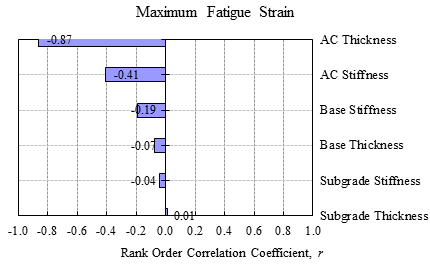
Figure 208. Graph. Sensitivity of pavement properties on maximum fatigue strain.
Sensitivity of Indices to Critical Pavement Design Responses
In section 8.3, it was recommended that pavements be divided into the following AC thickness groupings when comparing indices for estimating fatigue strain:
In this section, the JULEA database of 15,000 pavement structures was grouped based on AC thickness to verify the sensitivity between deflection indices and fatigue strain.(26)
Pavement Structures with AC Layer Less Than 3 Inches (76.2 mm) Thick
For pavement structures with an AC layer less than 3 inches (76.2 mm) thick, the stiffness of the base, AC, and subgrade layers as well as the thickness of the base layer significantly influenced the fatigue strain. Accordingly, a weak correlation between the deflection indices and fatigue strains was observed only when the AC thickness was considered. Similar trends were observed in the 3D-Move analyses.
It is hypothesized that the contribution of thin AC layers to the measured deflections is limited, and hence other factors must be taken into consideration to establish deflection index-fatigue strain correlations with a high degree of correlation. However, for network-level PMS applications, a relation involving multiple material properties is not practical, and hence such a relation was not pursued further.
Pavement Structures with AC Layer Between 3 and 6 Inches (76.2 and 152.4 mm) Thick
Figure 209 shows the relative sensitivity of maximum fatigue strain to selected deflection indices for pavement structures with an AC layer thickness between 3 and 6 inches (76.2 and 152.4 mm). As shown, all the indices presented in table 71 have relatively good correlation with maximum fatigue strain.
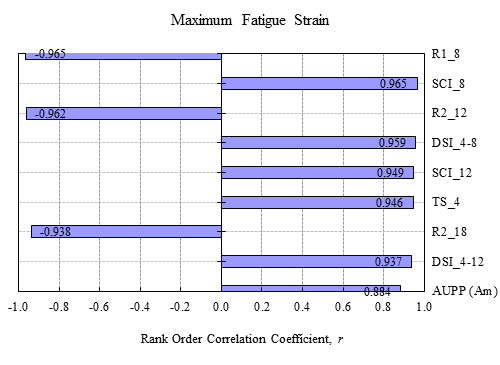
Figure 209. Graph. Sensitivity of curvature index on maximum fatigue strain in thin pavements.
Pavement Structures with AC Layer Between 6 and 16 Inches (152.4 and 406.4 mm) Thick
Figure 210 shows the relative sensitivity of maximum fatigue strain to selected deflection indices for pavement structures with an AC layer thickness between 6 and 16 inches (152.4 and 406.4 mm). As shown, all the indices presented in table 71 had relatively good correlation with maximum fatigue strain.
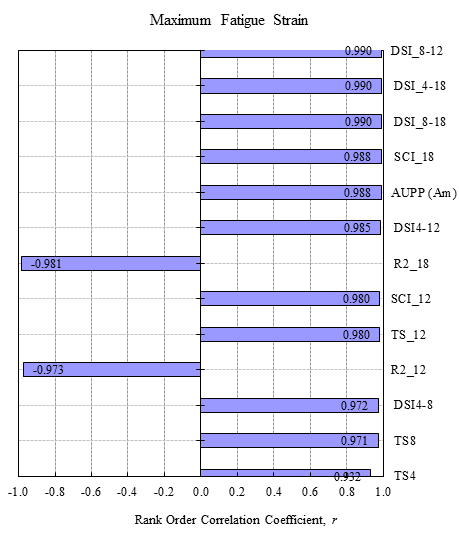
Figure 210. Graph. Sensitivity of curvature index on maximum fatigue strain in thick pavements.
Pavement Structures with Unknown AC Layer Thickness
Figure 209 and figure 210 show that, unlike other indices, the R212 index appears to be a reasonable predictor of maximum fatigue strain for pavements with both thin and thick AC layers. Accordingly, when the AC thickness is not known, the R212 index can be used to estimate maximum fatigue strains based on measured TSDD deflections, as suggested by the 3D-Move sensitivity analyses.
Relationship between Indices and Critical Response
Incorporating TSDD measurements into network-level PMS applications requires an established relationship between the computed or measured indices and fatigue strain. In this section, the fatigue strain was related to the indices deemed sensitive in the previous section and also from the 3D-Move analysis. Table 73 presents the relationships developed for pavement structures with thin (3 to 6 inches (76.2 to 152.4 mm)) and thick (6 to 16 inches ((152.4 to 406.4 mm)) AC layers. The correlation coefficient associated with each relationship is also presented in the table. For thin AC layers, separate relationships were developed for those cases where the AC layer thickness (H1) is greater than the base layer thickness (H2) (i.e., H1/H2 > 1).
| AC Layer Thickness | Pavement Sections | Chosen Best Indices | Relation | R2 |
|---|---|---|---|---|
| Thin (3 to 6 inches) | All | SCI8 (mil) | 98.754 × SCI80.8915 | 0.93 |
| (H1/H2) > 1 | 100.79 × SCI80.8958 | 0.96 | ||
| Thick (6 to 16 inches) | All | SCI18 (mil) | 40.224 × SCI180.9257 | 0.98 |
| Unknown | All | R212 (inches) | 337974 × R212-0.779 | 0.97 |
1 inch = 25.4 mm
Because the relations between the deflection indices and maximum fatigue strain can be sensitive to AC layer thickness, better predictions of the maximum fatigue strains are possible when the AC thickness is known or measured during the TSDD testing. The JULEA database was used to categorize the pavement structures according to AC layer thickness in 1-inch (25.4-mm) intervals.(26) Each group contained about 1,000 pavement structures within the pavement properties presented in table 72. Table 74 summarizes the relationships between the most sensitive deflection indices and the fatigue strain for each group. The correlation coefficient for each relationship is also presented in table 74.
| AC Layer Thickness (inches) | Unbound Layer Properties | Chosen Index | Range of Indices Value (mil) | Maximum Fatigue Strain (microstrain) | R2 |
|---|---|---|---|---|---|
| 3–4 | Base 20–80 ksi and 4–12 inches; subgrade 5–20 ksi and 24–240 inches |
SCI8 | 1.59 to 8.55 | 83.958 x SCI80.9903 | 0.90 |
| 4–5 | 1.23 to 6.65 | 90.107 x SCI81.0049 | 0.95 | ||
| 5–6 | 0.96 to 4.83 | 98.847 x SCI80.9723 | 0.97 | ||
| 6–7 | Base 20–80 ksi and 4–20 inches; subgrade 5–20 ksi and 24–240 inches |
SCI18 | 1.87 to 10.22 | 36.295 x SCI181.0096 | 0.92 |
| 7–8 | 1.58 to 11.07 | 37.106 x SCI181.0029 | 0.95 | ||
| 8–9 | 1.38 to 7.33 | 38.252 x SCI180.986 | 0.97 | ||
| 9–10 | 1.16 to 7.45 | 39.638 x SCI180.9611 | 0.98 | ||
| 10–11 | 1.02 to 6.89 | 40.933 x SCI180.9195 | 0.97 | ||
| 11–12 | 0.87 to 6.07 | 41.393 x SCI180.894 | 0.97 | ||
| 12–13 | 0.79 to 5.1 | 41.505 x SCI180.8672 | 0.96 | ||
| 13–14 | 0.69 to 4.68 | 41.301 x SCI180.8283 | 0.95 | ||
| 14–15 | 0.63 to 4.23 | 40.361 x SCI180.8313 | 0.96 | ||
| 15–16 | 0.59 to 4.27 | 39.278 x SCI180.7978 | 0.95 |
1 inch = 25.4 mm
ksi = 6.89 MPa
The RWD and TSD used in the MnROAD field trials had different loading configurations, as summarized in table 75. To study the effect of loading configuration on the relationship between deflection index and fatigue strain, a separate database of 50,000 pavement structures, each subjected to the TSD and RWD loading configurations, was simulated within the pavement properties presented in table 72.
| TSDD Equipment | Dual Tire Load (lb) | Tire Pressure (psi) | Dual Tire Spacing (inches) |
|---|---|---|---|
| TSD | 11,150 | 116 | 13.5 |
| RWD | 9,500 | 100 | 14.5 |
1 lb = 0.454 kg
1 psi = 6.89 kPa
1 inch = 25.4 mm
Figure 211 and figure 212 show the relationships between SCI12 and fatigue strain for the RWD and TSD loading configurations, respectively. The similarity between the two confirms that the proposed relationships are not dependent on the loading configuration, as was also found during the 3D-Move analysis.

1 mil = 0.0254 mm
Figure 211. Graph. General relationship between maximum fatigue strain and SCI for RWD loading.

1 mil = 0.0254 mm
Figure 212. Graph. General relationship between maximum fatigue strain and SCI for TSD loading.
So far, the focus of this chapter has been mostly on numerical analyses in order to recommend the most appropriate indices. In this section, the estimated TSD accuracies and precisions reported in chapter 6 were used to estimate the most practical and robust indices among those reported in previous sections. For this evaluation, the TSD new deflection algorithm discussed in chapter 5 was used since the old method did not provide enough data points for the analyses. Since the new TSD algorithm provides deflections at 4-inch (100.6-mm) intervals, including D0, only indices that conformed to this spacing were addressed. These values, along with the TS directly measured by the TSD, were used to evaluate the precision and accuracy of the most appropriate indices using the data collected during the MnROAD testing. The following subsections describe the process and the results obtained from such evaluation. It should be noted that the trends and recommendations in this section are based on the limited data collected during the MnROAD field testing and are subject to the uncertainties associated with the measurements and analyses enumerated for the accuracy and precision studies outlined in chapters 5 and 6.
For the accuracy evaluation, the selected indices from the TSD were compared with the same indices calculated from the deflection or velocity basins measured with geophone 3 at all cells. The accuracy was evaluated in terms of the percentage of difference as established in chapters 5 and 6 for the deflection slopes irrespective of the AC thickness recommendations for estimating the strains. Figure 213 presents the results from such evaluation. The error bars in the figure correspond to the 25th and 75th percentile ranges of the difference. A 15 percent threshold median difference, which was considered as a reasonable level of difference given the state of the technology, was also added to the plot shown in figure 213. The indices based on the deflection slopes yielded lower difference values as compared to the other indices. The indices based on R seem to be the least accurate.
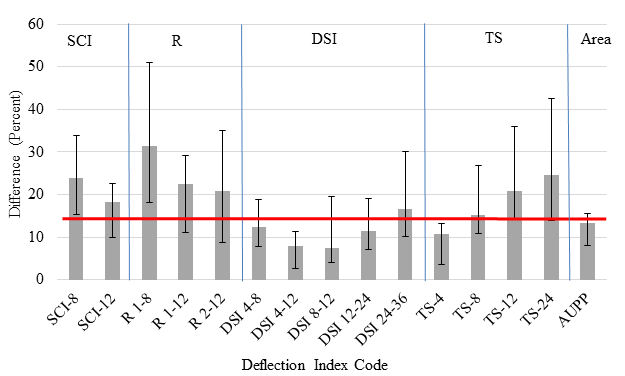
Figure 213. Graph. Accuracy evaluation of indices.
As presented in section 6.3, the new TSD vertical deflection estimates were found to be less precise than the deflection slope measurements. For this evaluation, precision was incorporated using the same approach but with a slightly different presentation of results. As in chapter 6, the SEE values and ranges were estimated for each index and cell. The median COV, obtained from the ratio between the median SEE and the median range, was used to quantify the precision of each deflection index irrespective of the AC thickness recommendations for estimating the strains. Figure 214 shows the resulting median COVs as well 25th and 75th percentile ranges of the COVs. A 15 percent threshold median COV was also added to the plot as a reasonable precision. Most indices were under this 15 percent threshold COV. As shown, the indices based on the deflection slopes performed better than those based on the TSs by themselves. The three R indices performed the worst, with median COVs ranging from 29 to 40 percent.
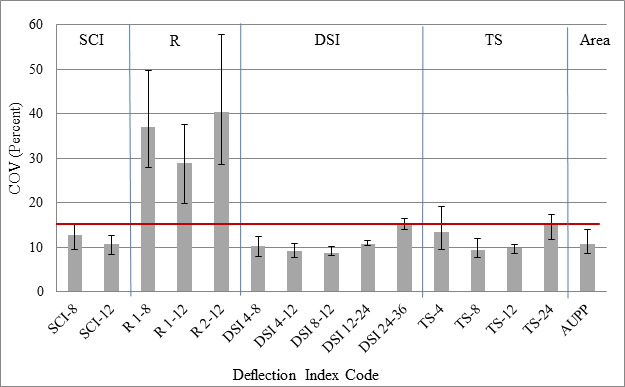
Figure 214. Graph. Precision evaluation of indices.
To easily visualize the overall performance of these indices, figure 215 was developed by combining figure 213 and figure 214. This plot, which presents the precision results on the abscissa and the accuracy results on the ordinance, is segmented into four quadrants to further characterize the performance of the indices in question. As shown, the most robust indices are those in the lower left quadrant (marked in green) and include four DSIs, TS4, and AUPP. The indices in the upper left quadrant (TS and SCI) may also be considered as reasonably precise but not as accurate as those in the lower left quadrant. Based on this study, the three radii of curvature indices under consideration do not seem to yield accurate enough results since they all fall in the upper right-hand quadrant (i.e., quadrant with low accuracy and precision marked in red). DSI4 - 12 was found to be the most robust index based on the TSDD accuracy and precision analyses conducted in this study.
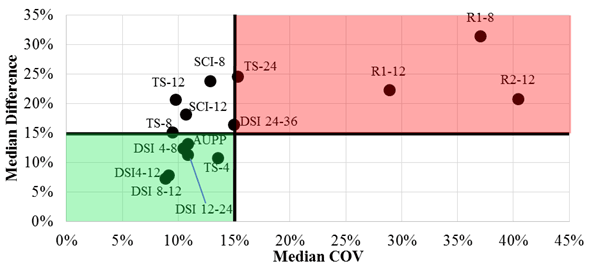
Figure 215. Graph. Overall field performance of indices.
The uncertainties of the modeled indices were evaluated by dividing the SEE in estimating the maximum fatigue strain by the median range of calculated strains for each of the indices for different AC thicknesses as described previously. The results from such analysis are presented in figure 216. This figure depicts the same 15 percent threshold as described in section 8.5. Most of the indices have a median COV below 15 percent except for the ones used to determine the strain for unknown pavement thickness.
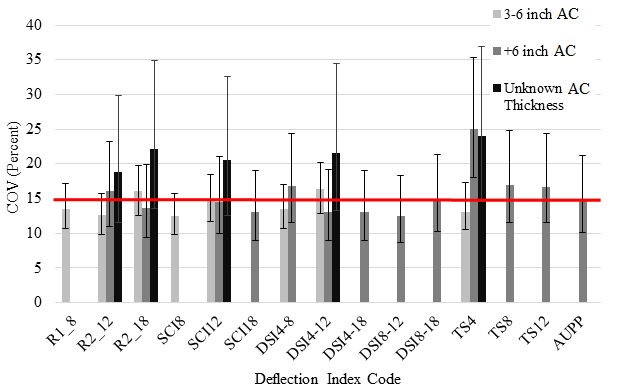
1 inch = 25.4 mm
Figure 216. Graph. Precision of modeled indices in different pavement thicknesses<
The overall performance of the selected indices was evaluated by combining the field and JULEA results.(26) The outcomes from figure 214 through figure 216 were combined into table 76. Indices were then ranked within their pavement thickness ranges according to a performance number (see table 77). The device precisions, device accuracies, and model uncertainties were assigned values of 1 (poor) when their COV values were greater than 20 percent, 3 (fair) when their values were between 10 and 20 percent, and 5 (good) for values less than 10 percent. Similarly, the R2 values were assigned 1 (poor) for values less than 0.90, 3 (fair) for values between 0.90 and 0.95, and 5 (good) for values above 0.95.
| AC Thickness of Pavement Section | Index | Units | Precision COV (Percent) | Accuracy (Percent Difference) | Model COV (Percent) | Model R2 |
|---|---|---|---|---|---|---|
| Between 3 and 6 inches | DSI4 - 12 | mil | 9 | 8 | 16 | 0.88 |
| SCI12 | mil | 11 | 18 | 15 | 0.90 | |
| DSI4 - 8 | mil | 10 | 12 | 13 | 0.92 | |
| TS4 | mil/inch | 14 | 11 | 13 | 0.91 | |
| SCI8 | mil | 13 | 24 | 12 | 0.93 | |
| R18 | inches | 37 | 31 | 14 | 0.93 | |
| R212 | inches | 40 | 21 | 13 | 0.93 | |
| Greater than 6 inches | DSI4 - 12 | mil | 9 | 8 | 13 | 0.97 |
| DSI8 - 12 | mil | 9 | 7 | 12 | 0.98 | |
| SCI12 | mil | 11 | 18 | 14 | 0.96 | |
| DSI4 - 8 | mil | 10 | 12 | 17 | 0.95 | |
| TS8 | mil/inch | 9 | 15 | 17 | 0.94 | |
| TS12 | mil/inch | 10 | 21 | 17 | 0.96 | |
| AUPP | mil | 11 | 13 | 15 | 0.97 | |
| R212 | inches | 40 | 21 | 16 | 0.95 | |
| TS4 | mil/inch | 14 | 11 | 25 | 0.87 | |
| Unknown | DSI4 - 12 | mil | 9 | 8 | 22 | 0.97 |
| SCI12 | mil | 11 | 18 | 20 | 0.97 | |
| R212 | inches | 40 | 21 | 19 | 0.97 | |
| TS4 | mil/inch | 14 | 11 | 24 | 0.93 |
1 inch = 25.4 mm
1 mil = 0.0254 mm
1 mil/inch = 0.0001 mm/mm
| AC Thickness of Pavement Section | Index | Units | Device Precision | Device Accuracy | Model Uncertainty | Model R2 | Overall Performance (1–5) |
|---|---|---|---|---|---|---|---|
| Between 3 and 6 inches | DSI4 - 12 | mil | 5 | 5 | 3 | 1 | 3.5 |
| SCI12 | mil | 3 | 3 | 3 | 3 | 3.0 | |
| DSI4 - 8 | mil | 3 | 3 | 3 | 3 | 3.0 | |
| TS4 | mil/inch | 3 | 3 | 3 | 3 | 3.0 | |
| SCI8 | mil | 3 | 1 | 3 | 3 | 2.5 | |
| R18 | inches | 1 | 1 | 3 | 3 | 2.0 | |
| R212 | inches | 1 | 1 | 3 | 3 | 2.0 | |
| Greater than 6 inches | DSI4 - 12 | mil | 5 | 5 | 3 | 5 | 4.5 |
| DSI8 - 12 | mil | 5 | 5 | 3 | 5 | 4.5 | |
| SCI12 | mil | 3 | 3 | 3 | 5 | 3.5 | |
| DSI4 - 8 | mil | 3 | 3 | 3 | 5 | 3.5 | |
| TS8 | mil/inch | 5 | 3 | 3 | 3 | 3.5 | |
| TS12 | mil/inch | 5 | 1 | 3 | 5 | 3.5 | |
| AUPP | mil | 3 | 3 | 3 | 5 | 3.5 | |
| R212 | inches | 1 | 1 | 3 | 5 | 2.5 | |
| TS4 | mil/inch | 3 | 3 | 1 | 1 | 2.0 | |
| Unknown | DSI4 - 12 | mil | 5 | 5 | 1 | 5 | 4.0 |
| SCI12 | mil | 3 | 3 | 1 | 5 | 3.0 | |
| R212 | inches | 1 | 1 | 3 | 5 | 2.5 | |
| TS4 | mil/inch | 3 | 3 | 1 | 3 | 2.5 |
1 inch = 25.4 mm
1 mil = 0.0254 mm
1 mil/inch = 0.0001 mm/mm
Note: A ranking of 1 indicates poor, a ranking of 3 indicates fair, and a ranking of 5 indicates good.
The overall performance was then determined by assigning a 25 percent importance to each of the four parameters (device precision, device accuracy, model uncertainty, and R2) and obtaining a weighted average of the four parameters. Indices that required a deflection parameter of 18 inches (457.2 mm) were not included in this table since TSD did not report a value at that distance. DSI4 - 12 appears first on the three different AC thicknesses categories. SCI12 also performed well in the three AC thickness categories with an overall performance of 3 or higher. It should be noted that device accuracy can be improved if the effectiveness of the deflection algorithm is improved. At a minimum, the TSD old deflection algorithm, which was identified in accuracy analysis (section 6.2) to be better than new deflection algorithm, can be modified to compute the deflections at the locations needed to determine the identified effective indices.
In considering the results and conclusions presented in this chapter, it is important to recognize that a limitation of the analyses is that the device precision and accuracy were obtained for pavements with a AC thickness of 5 inches (127 mm) or less if the full depth reclamation with engineered emulsion is not considered as AC. The most robust index, DSI4 - 12, is related to maximum fatigue strain using the JULEA database and is presented in table 78.
| AC Layer Thickness (inches) | Maximum Fatigue Strain (microstrain) | R2 |
|---|---|---|
| 3–6 (thin AC) | 69.1 x DSI4 - 120.9348 | 0.88 |
| 6–16 (thick AC) | 76.22 x DSI4 - 120.8924 | 0.97 |
| Unknown | 76.24 x DSI4 - 120.8969 | 0.97 |
| 3–4 | 66.96 x DSI4 - 120.9351 | 0.77 |
| 4–5 | 62.567 x DSI4 - 121.0174 | 0.88 |
| 5–6 | 64.66 x DSI4 - 121.0379 | 0.94 |
| 6–7 | 71.646 x DSI4 - 121.0005 | 0.96 |
| 7–8 | 74.381 x DSI4 - 120.9757 | 0.97 |
| 8–9 | 76.458 x DSI4 - 120.9427 | 0.98 |
| 9–10 | 77.802 x DSI4 - 120.9107 | 0.97 |
| 10–11 | 77.868 x DSI4 - 120.8674 | 0.96 |
| 11–12 | 76.861 x DSI4 - 120.8395 | 0.95 |
| 12–13 | 75.154 x DSI4 - 120.8149 | 0.95 |
| 13–14 | 72.194 x DSI4 - 120.778 | 0.94 |
| 14–15 | 70.196 x DSI4 - 120.7824 | 0.94 |
| 15–16 | 66.402 x DSI4 - 120.7525 | 0.93 |
1 inch = 25.4 mm
The deflection parameter measured by the TSDD is a function of pavement temperature at the structural evaluation. Consistent evaluation and tracking of the index computed from deflection parameters over the pavement service period requires the maximum fatigue strains computed from the index to be corrected to a standard reference temperature. The recommended approach, developed as part of the project, is as follows:
![]()
![]()
Figure 217. Equation. Temperature correction factor.
* Modified November 21, 2016
Where:
Tf (°F) = Temperature at time of the TSDD field measurements.
Tr (°F) = Reference temperature, which should be set to 70 °F (21.11°C).
![]()
Figure 218. Equation. Dynamic modulus at reference temperature.
While the correlation coefficients for the relations in table 79 are not high, the error in the temperature corrections is expected to be minimal because the same relations are used to compute the AC dynamic modulus from the computed strains and then to re-compute the strains from the temperature corrected AC dynamic modulus.
| AC Layer Thickness (inches) | Relation Between Maximum Fatigue Strain and AC Modulus | R2 |
|---|---|---|
| 3–4 | 5.28E+08 x ε max-1.27 | 0.47 |
| 4–5 | 6.56E+08 x ε max -1.36 | 0.59 |
| 5–6 | 7.23E+08 x ε max-1.44 | 0.62 |
| 6–7 | 6.39E+08 x ε max-1.46 | 0.67 |
| 7–8 | 4.96E+08 x ε max-1.46 | 0.68 |
| 8–9 | 4.91E+08 x ε max-1.51 | 0.72 |
| 9–10 | 3.68E+08 x ε max-1.49 | 0.76 |
| 10–11 | 3.29E+08 x ε max-1.51 | 0.77 |
| 11–12 | 2.88E+08 x ε max-1.52 | 0.79 |
| 12–13 | 2.50E+08 x ε max-1.53 | 0.83 |
| 13–14 | 2.30E+08 x ε max-1.55 | 0.83 |
| 14–15 | 1.61E+08 x ε max-1.49 | 0.85 |
| 15–16 | 1.45E+08 x ε max-1.51 | 0.85 |